International Marketing and Sales: PureGym Expansion in US
VerifiedAdded on 2023/01/09
|23
|6578
|56
AI Summary
This document provides a comprehensive marketing plan for PureGym's expansion in the US. It covers the value proposition, SWOT analysis, marketing objectives, tactics, and action plan. It also explores Mendelow's Model and Porter's Value Chain Model. The document discusses the challenges and opportunities in the US market.
Contribute Materials
Your contribution can guide someone’s learning journey. Share your
documents today.
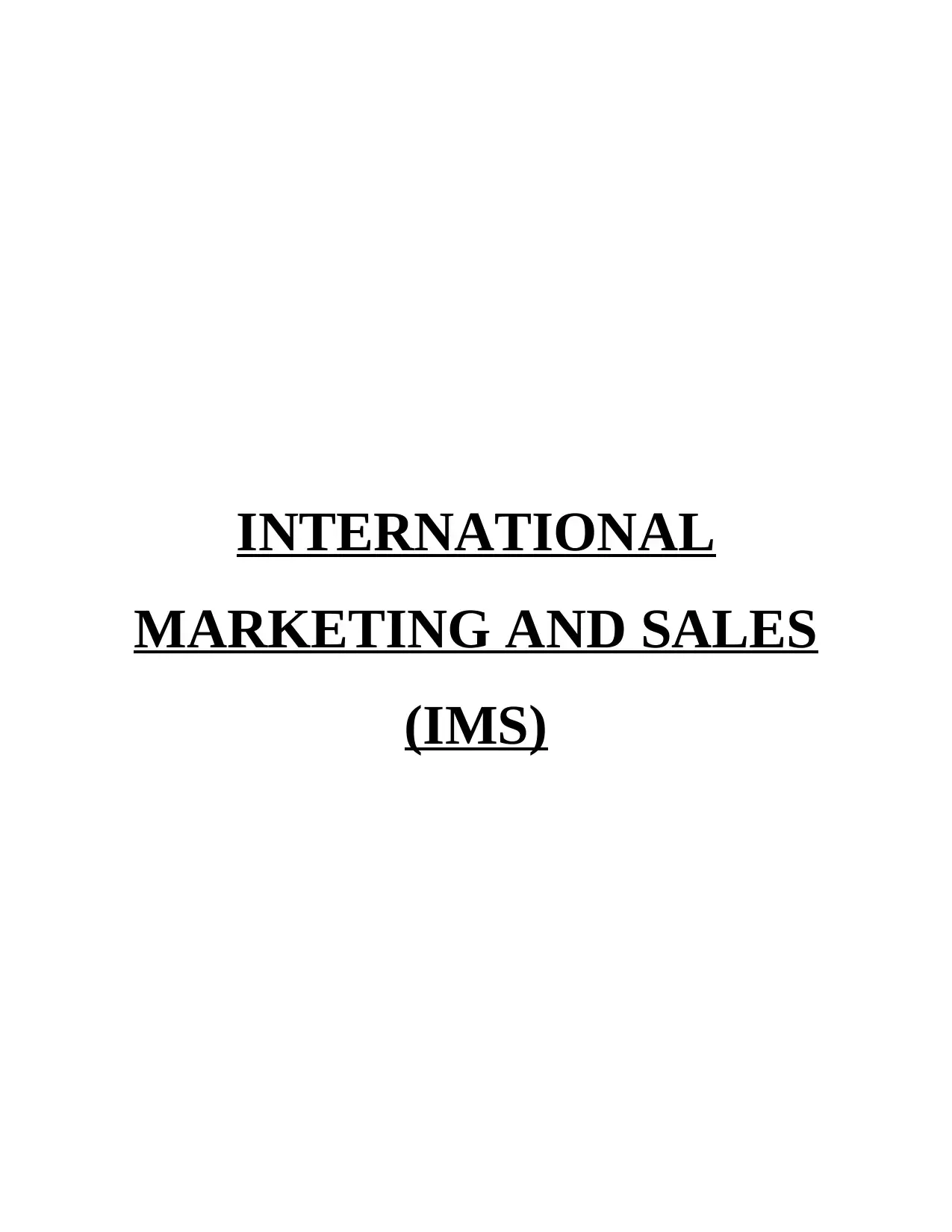
INTERNATIONAL
MARKETING AND SALES
(IMS)
MARKETING AND SALES
(IMS)
Secure Best Marks with AI Grader
Need help grading? Try our AI Grader for instant feedback on your assignments.
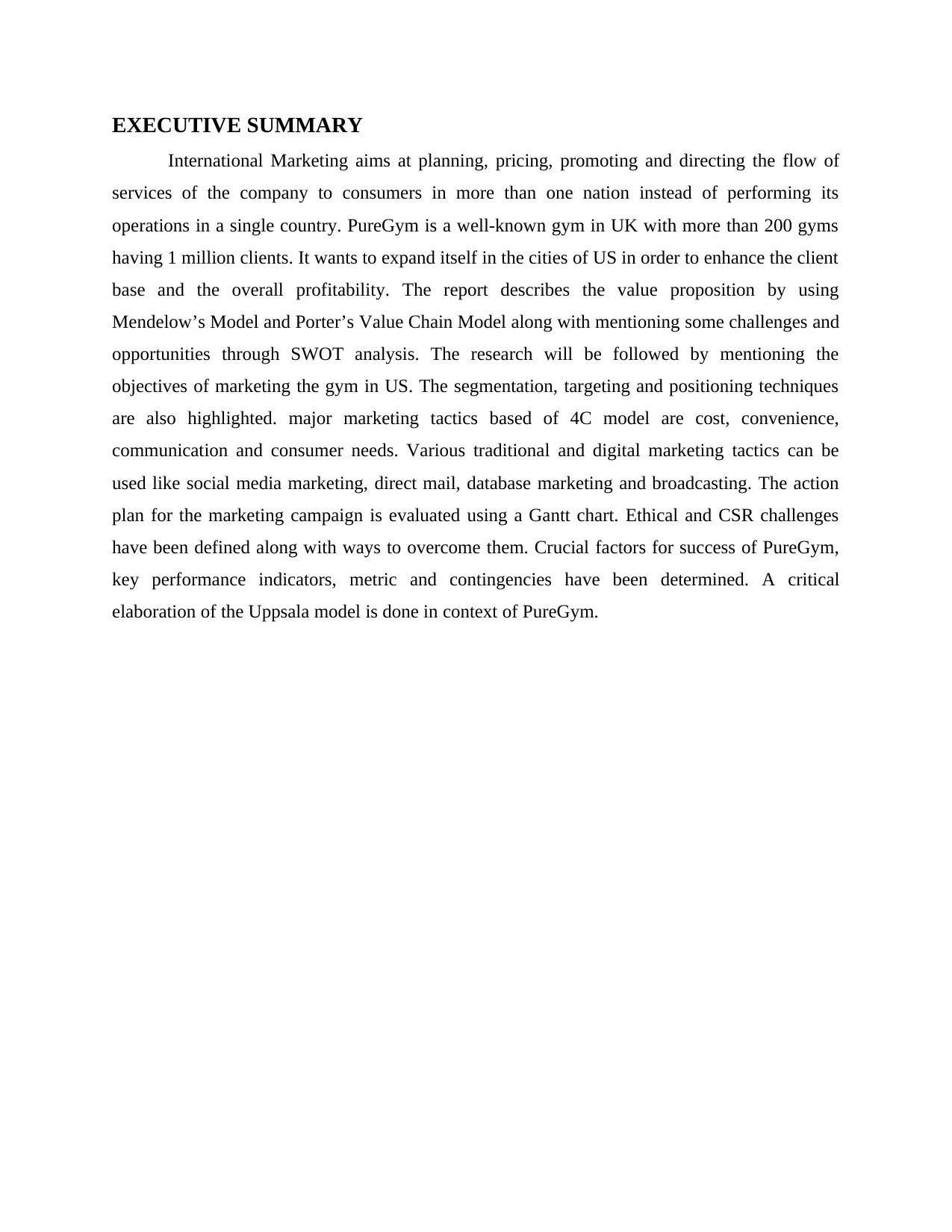
EXECUTIVE SUMMARY
International Marketing aims at planning, pricing, promoting and directing the flow of
services of the company to consumers in more than one nation instead of performing its
operations in a single country. PureGym is a well-known gym in UK with more than 200 gyms
having 1 million clients. It wants to expand itself in the cities of US in order to enhance the client
base and the overall profitability. The report describes the value proposition by using
Mendelow’s Model and Porter’s Value Chain Model along with mentioning some challenges and
opportunities through SWOT analysis. The research will be followed by mentioning the
objectives of marketing the gym in US. The segmentation, targeting and positioning techniques
are also highlighted. major marketing tactics based of 4C model are cost, convenience,
communication and consumer needs. Various traditional and digital marketing tactics can be
used like social media marketing, direct mail, database marketing and broadcasting. The action
plan for the marketing campaign is evaluated using a Gantt chart. Ethical and CSR challenges
have been defined along with ways to overcome them. Crucial factors for success of PureGym,
key performance indicators, metric and contingencies have been determined. A critical
elaboration of the Uppsala model is done in context of PureGym.
International Marketing aims at planning, pricing, promoting and directing the flow of
services of the company to consumers in more than one nation instead of performing its
operations in a single country. PureGym is a well-known gym in UK with more than 200 gyms
having 1 million clients. It wants to expand itself in the cities of US in order to enhance the client
base and the overall profitability. The report describes the value proposition by using
Mendelow’s Model and Porter’s Value Chain Model along with mentioning some challenges and
opportunities through SWOT analysis. The research will be followed by mentioning the
objectives of marketing the gym in US. The segmentation, targeting and positioning techniques
are also highlighted. major marketing tactics based of 4C model are cost, convenience,
communication and consumer needs. Various traditional and digital marketing tactics can be
used like social media marketing, direct mail, database marketing and broadcasting. The action
plan for the marketing campaign is evaluated using a Gantt chart. Ethical and CSR challenges
have been defined along with ways to overcome them. Crucial factors for success of PureGym,
key performance indicators, metric and contingencies have been determined. A critical
elaboration of the Uppsala model is done in context of PureGym.

TABLE OF CONTENTS
EXECUTIVE SUMMARY.............................................................................................................2
INTRODUCTION...........................................................................................................................4
TASK 1: Marketing Plan.................................................................................................................4
1.1: Value Proposition.................................................................................................................4
1.2: SWOT Analysis....................................................................................................................8
1.3: Marketing Objectives.........................................................................................................10
1.4: Strategic Marketing Plan....................................................................................................10
1.5: Marketing Tactics...............................................................................................................11
1.6: Action Plan, Budgets and Financials..................................................................................15
1.7: Ethics, Sustainability and CSR...........................................................................................18
1.8: Controls, Measurement & Contingencies...........................................................................18
TASK 2..........................................................................................................................................20
The UPPSALA Model...............................................................................................................20
CONCLUSION..............................................................................................................................21
REFERENCES..............................................................................................................................22
EXECUTIVE SUMMARY.............................................................................................................2
INTRODUCTION...........................................................................................................................4
TASK 1: Marketing Plan.................................................................................................................4
1.1: Value Proposition.................................................................................................................4
1.2: SWOT Analysis....................................................................................................................8
1.3: Marketing Objectives.........................................................................................................10
1.4: Strategic Marketing Plan....................................................................................................10
1.5: Marketing Tactics...............................................................................................................11
1.6: Action Plan, Budgets and Financials..................................................................................15
1.7: Ethics, Sustainability and CSR...........................................................................................18
1.8: Controls, Measurement & Contingencies...........................................................................18
TASK 2..........................................................................................................................................20
The UPPSALA Model...............................................................................................................20
CONCLUSION..............................................................................................................................21
REFERENCES..............................................................................................................................22
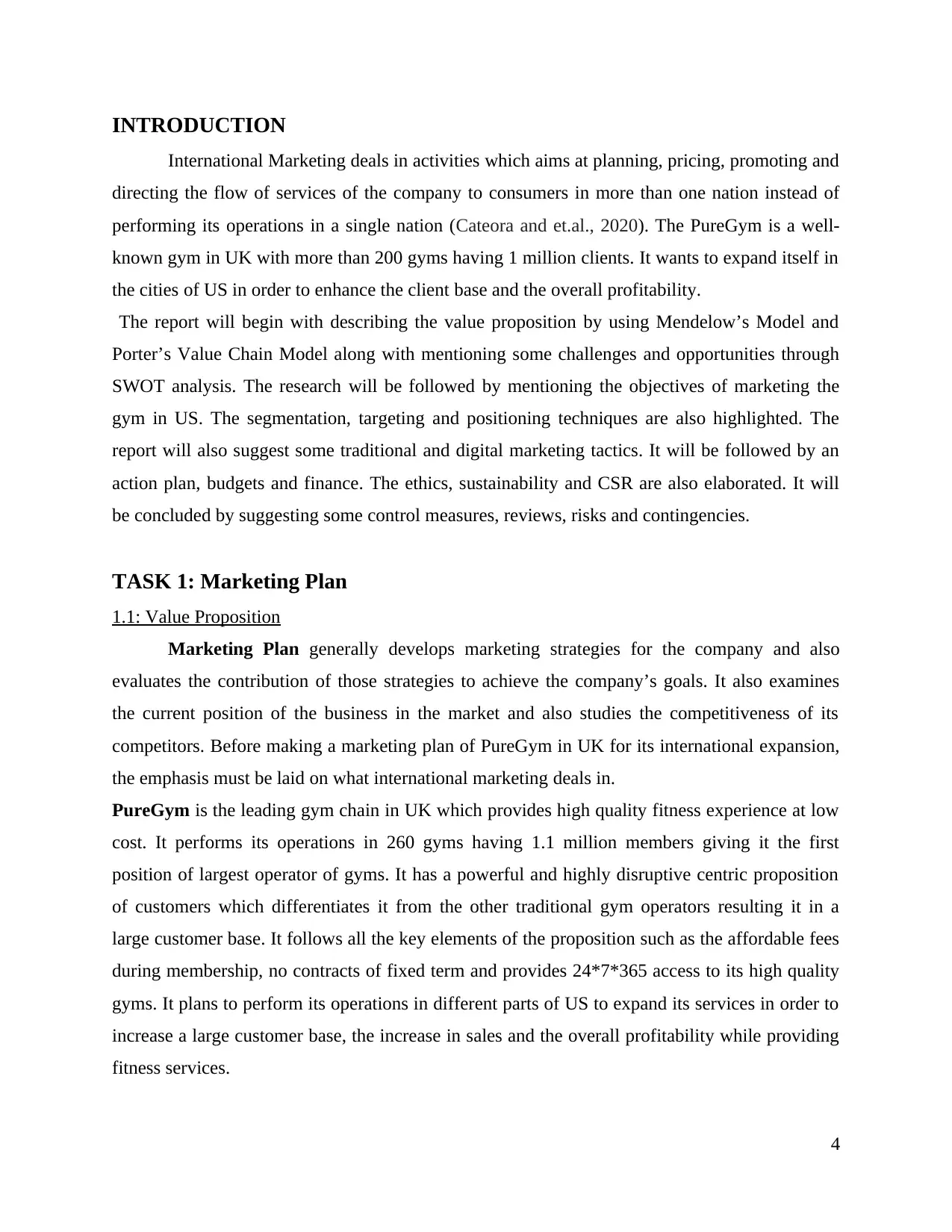
INTRODUCTION
International Marketing deals in activities which aims at planning, pricing, promoting and
directing the flow of services of the company to consumers in more than one nation instead of
performing its operations in a single nation (Cateora and et.al., 2020). The PureGym is a well-
known gym in UK with more than 200 gyms having 1 million clients. It wants to expand itself in
the cities of US in order to enhance the client base and the overall profitability.
The report will begin with describing the value proposition by using Mendelow’s Model and
Porter’s Value Chain Model along with mentioning some challenges and opportunities through
SWOT analysis. The research will be followed by mentioning the objectives of marketing the
gym in US. The segmentation, targeting and positioning techniques are also highlighted. The
report will also suggest some traditional and digital marketing tactics. It will be followed by an
action plan, budgets and finance. The ethics, sustainability and CSR are also elaborated. It will
be concluded by suggesting some control measures, reviews, risks and contingencies.
TASK 1: Marketing Plan
1.1: Value Proposition
Marketing Plan generally develops marketing strategies for the company and also
evaluates the contribution of those strategies to achieve the company’s goals. It also examines
the current position of the business in the market and also studies the competitiveness of its
competitors. Before making a marketing plan of PureGym in UK for its international expansion,
the emphasis must be laid on what international marketing deals in.
PureGym is the leading gym chain in UK which provides high quality fitness experience at low
cost. It performs its operations in 260 gyms having 1.1 million members giving it the first
position of largest operator of gyms. It has a powerful and highly disruptive centric proposition
of customers which differentiates it from the other traditional gym operators resulting it in a
large customer base. It follows all the key elements of the proposition such as the affordable fees
during membership, no contracts of fixed term and provides 24*7*365 access to its high quality
gyms. It plans to perform its operations in different parts of US to expand its services in order to
increase a large customer base, the increase in sales and the overall profitability while providing
fitness services.
4
International Marketing deals in activities which aims at planning, pricing, promoting and
directing the flow of services of the company to consumers in more than one nation instead of
performing its operations in a single nation (Cateora and et.al., 2020). The PureGym is a well-
known gym in UK with more than 200 gyms having 1 million clients. It wants to expand itself in
the cities of US in order to enhance the client base and the overall profitability.
The report will begin with describing the value proposition by using Mendelow’s Model and
Porter’s Value Chain Model along with mentioning some challenges and opportunities through
SWOT analysis. The research will be followed by mentioning the objectives of marketing the
gym in US. The segmentation, targeting and positioning techniques are also highlighted. The
report will also suggest some traditional and digital marketing tactics. It will be followed by an
action plan, budgets and finance. The ethics, sustainability and CSR are also elaborated. It will
be concluded by suggesting some control measures, reviews, risks and contingencies.
TASK 1: Marketing Plan
1.1: Value Proposition
Marketing Plan generally develops marketing strategies for the company and also
evaluates the contribution of those strategies to achieve the company’s goals. It also examines
the current position of the business in the market and also studies the competitiveness of its
competitors. Before making a marketing plan of PureGym in UK for its international expansion,
the emphasis must be laid on what international marketing deals in.
PureGym is the leading gym chain in UK which provides high quality fitness experience at low
cost. It performs its operations in 260 gyms having 1.1 million members giving it the first
position of largest operator of gyms. It has a powerful and highly disruptive centric proposition
of customers which differentiates it from the other traditional gym operators resulting it in a
large customer base. It follows all the key elements of the proposition such as the affordable fees
during membership, no contracts of fixed term and provides 24*7*365 access to its high quality
gyms. It plans to perform its operations in different parts of US to expand its services in order to
increase a large customer base, the increase in sales and the overall profitability while providing
fitness services.
4
Secure Best Marks with AI Grader
Need help grading? Try our AI Grader for instant feedback on your assignments.
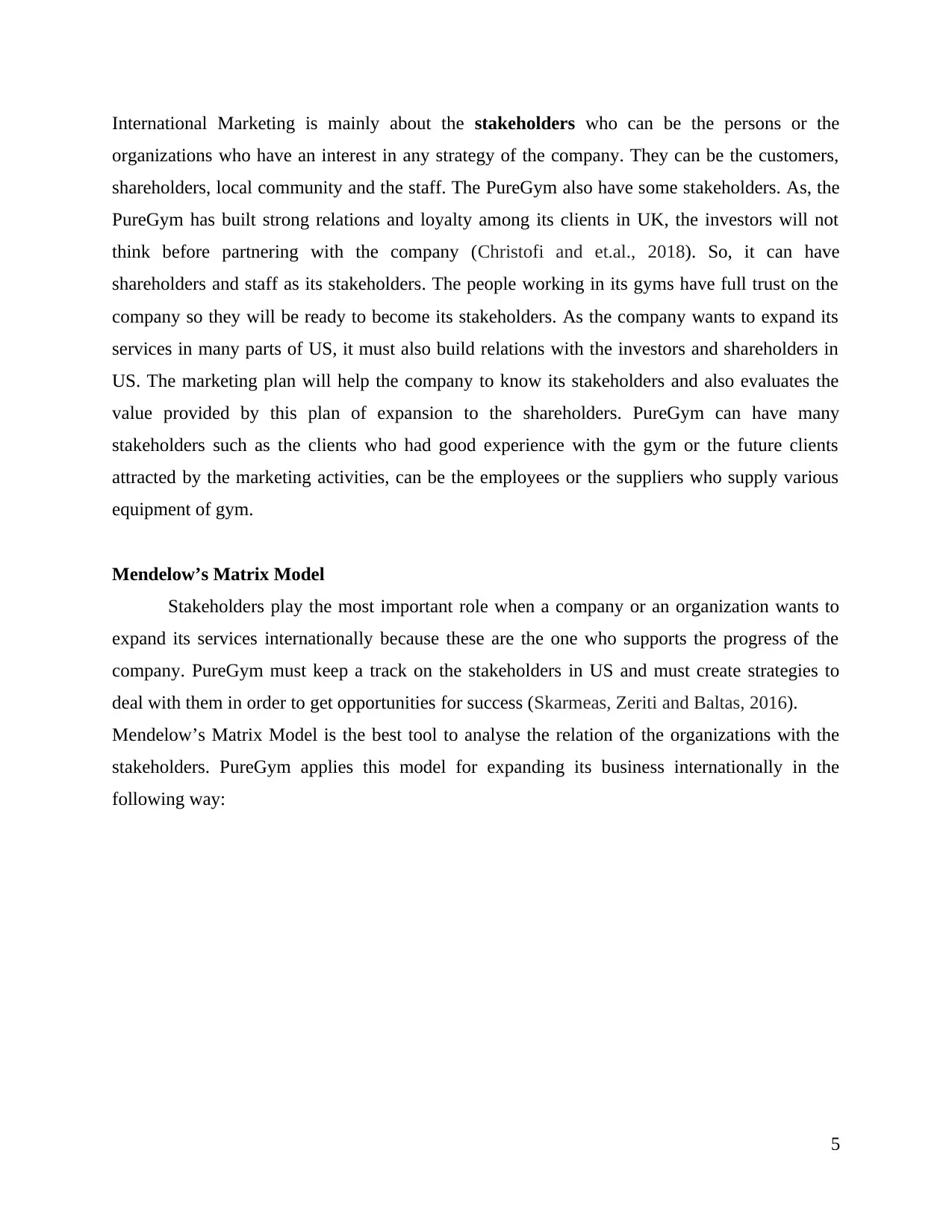
International Marketing is mainly about the stakeholders who can be the persons or the
organizations who have an interest in any strategy of the company. They can be the customers,
shareholders, local community and the staff. The PureGym also have some stakeholders. As, the
PureGym has built strong relations and loyalty among its clients in UK, the investors will not
think before partnering with the company (Christofi and et.al., 2018). So, it can have
shareholders and staff as its stakeholders. The people working in its gyms have full trust on the
company so they will be ready to become its stakeholders. As the company wants to expand its
services in many parts of US, it must also build relations with the investors and shareholders in
US. The marketing plan will help the company to know its stakeholders and also evaluates the
value provided by this plan of expansion to the shareholders. PureGym can have many
stakeholders such as the clients who had good experience with the gym or the future clients
attracted by the marketing activities, can be the employees or the suppliers who supply various
equipment of gym.
Mendelow’s Matrix Model
Stakeholders play the most important role when a company or an organization wants to
expand its services internationally because these are the one who supports the progress of the
company. PureGym must keep a track on the stakeholders in US and must create strategies to
deal with them in order to get opportunities for success (Skarmeas, Zeriti and Baltas, 2016).
Mendelow’s Matrix Model is the best tool to analyse the relation of the organizations with the
stakeholders. PureGym applies this model for expanding its business internationally in the
following way:
5
organizations who have an interest in any strategy of the company. They can be the customers,
shareholders, local community and the staff. The PureGym also have some stakeholders. As, the
PureGym has built strong relations and loyalty among its clients in UK, the investors will not
think before partnering with the company (Christofi and et.al., 2018). So, it can have
shareholders and staff as its stakeholders. The people working in its gyms have full trust on the
company so they will be ready to become its stakeholders. As the company wants to expand its
services in many parts of US, it must also build relations with the investors and shareholders in
US. The marketing plan will help the company to know its stakeholders and also evaluates the
value provided by this plan of expansion to the shareholders. PureGym can have many
stakeholders such as the clients who had good experience with the gym or the future clients
attracted by the marketing activities, can be the employees or the suppliers who supply various
equipment of gym.
Mendelow’s Matrix Model
Stakeholders play the most important role when a company or an organization wants to
expand its services internationally because these are the one who supports the progress of the
company. PureGym must keep a track on the stakeholders in US and must create strategies to
deal with them in order to get opportunities for success (Skarmeas, Zeriti and Baltas, 2016).
Mendelow’s Matrix Model is the best tool to analyse the relation of the organizations with the
stakeholders. PureGym applies this model for expanding its business internationally in the
following way:
5
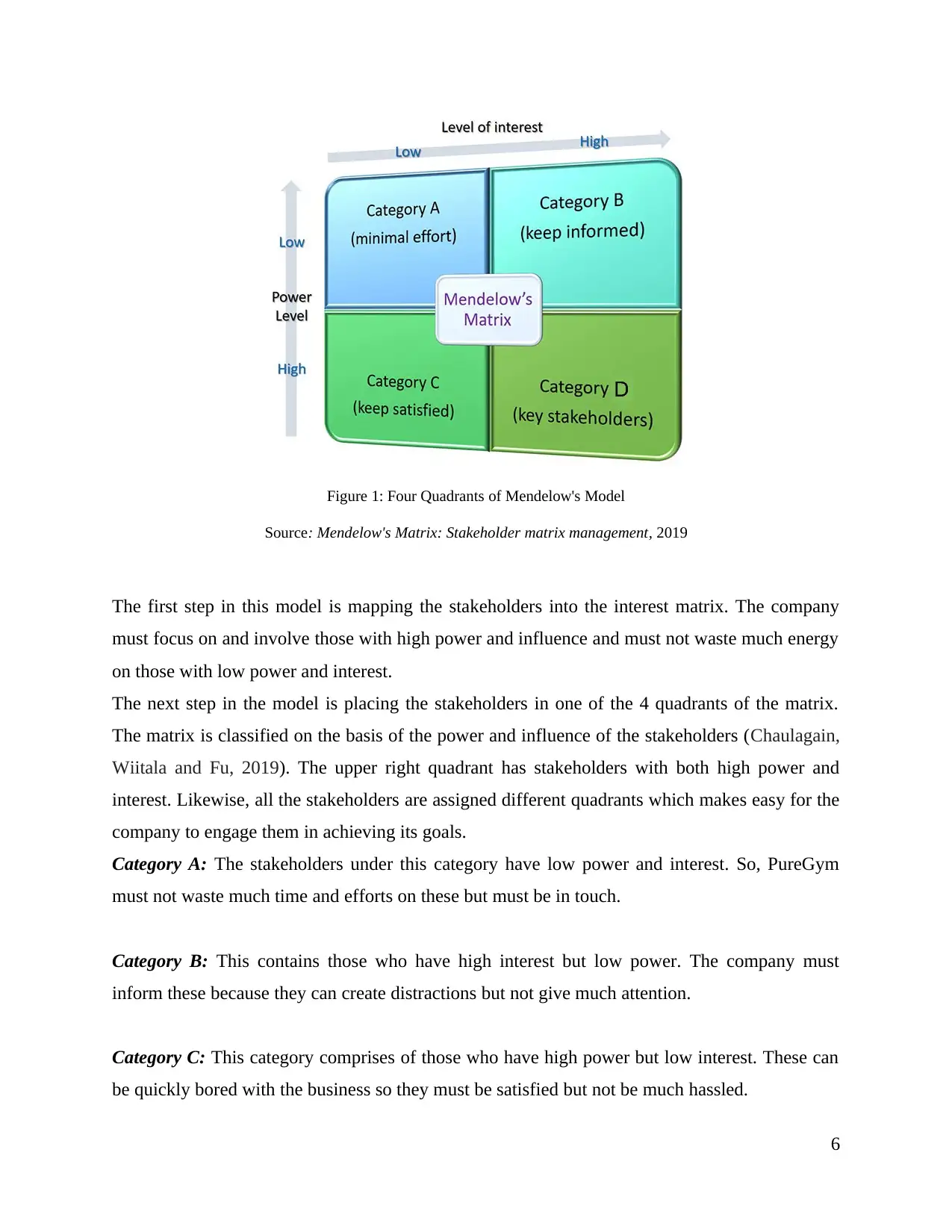
Figure 1: Four Quadrants of Mendelow's Model
Source: Mendelow's Matrix: Stakeholder matrix management, 2019
The first step in this model is mapping the stakeholders into the interest matrix. The company
must focus on and involve those with high power and influence and must not waste much energy
on those with low power and interest.
The next step in the model is placing the stakeholders in one of the 4 quadrants of the matrix.
The matrix is classified on the basis of the power and influence of the stakeholders (Chaulagain,
Wiitala and Fu, 2019). The upper right quadrant has stakeholders with both high power and
interest. Likewise, all the stakeholders are assigned different quadrants which makes easy for the
company to engage them in achieving its goals.
Category A: The stakeholders under this category have low power and interest. So, PureGym
must not waste much time and efforts on these but must be in touch.
Category B: This contains those who have high interest but low power. The company must
inform these because they can create distractions but not give much attention.
Category C: This category comprises of those who have high power but low interest. These can
be quickly bored with the business so they must be satisfied but not be much hassled.
6
Source: Mendelow's Matrix: Stakeholder matrix management, 2019
The first step in this model is mapping the stakeholders into the interest matrix. The company
must focus on and involve those with high power and influence and must not waste much energy
on those with low power and interest.
The next step in the model is placing the stakeholders in one of the 4 quadrants of the matrix.
The matrix is classified on the basis of the power and influence of the stakeholders (Chaulagain,
Wiitala and Fu, 2019). The upper right quadrant has stakeholders with both high power and
interest. Likewise, all the stakeholders are assigned different quadrants which makes easy for the
company to engage them in achieving its goals.
Category A: The stakeholders under this category have low power and interest. So, PureGym
must not waste much time and efforts on these but must be in touch.
Category B: This contains those who have high interest but low power. The company must
inform these because they can create distractions but not give much attention.
Category C: This category comprises of those who have high power but low interest. These can
be quickly bored with the business so they must be satisfied but not be much hassled.
6
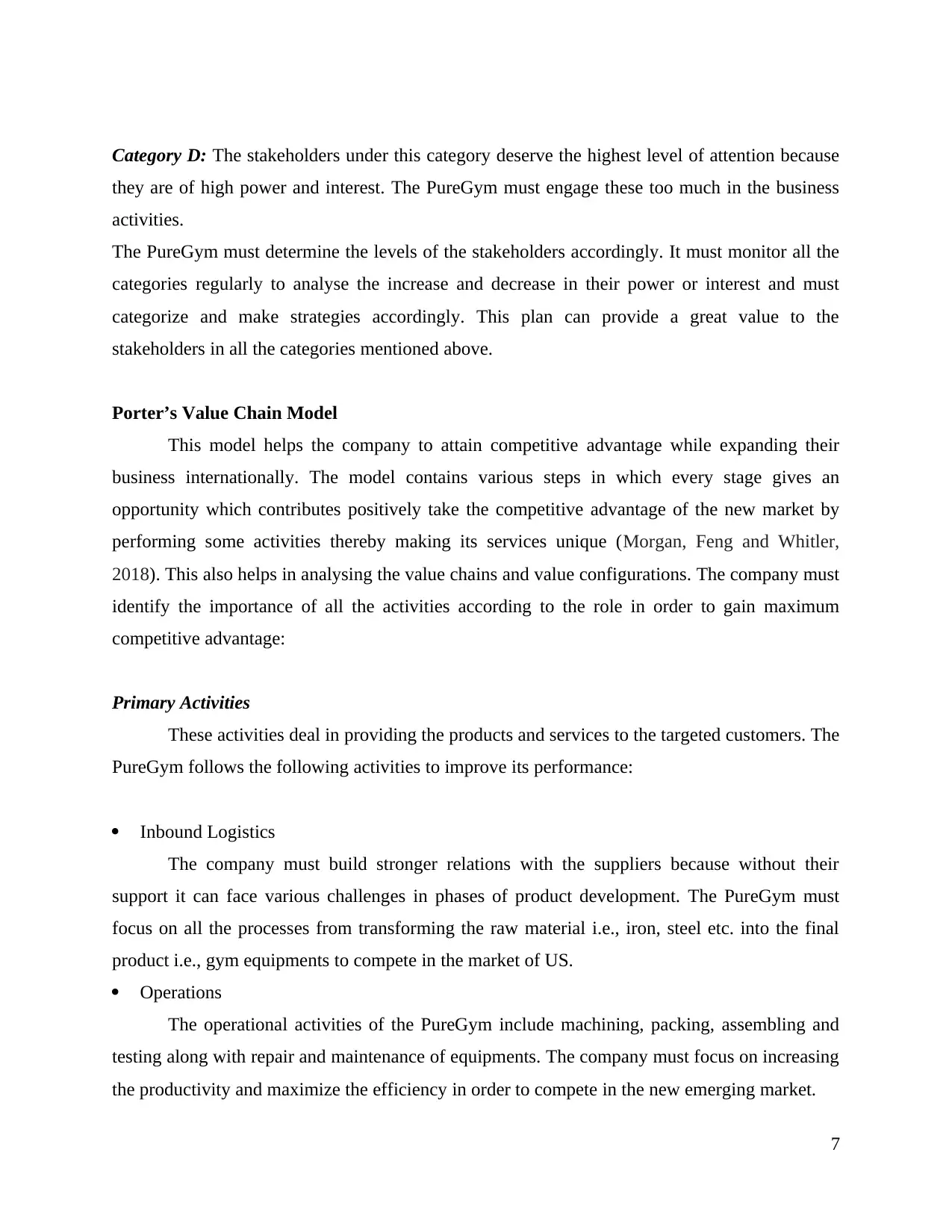
Category D: The stakeholders under this category deserve the highest level of attention because
they are of high power and interest. The PureGym must engage these too much in the business
activities.
The PureGym must determine the levels of the stakeholders accordingly. It must monitor all the
categories regularly to analyse the increase and decrease in their power or interest and must
categorize and make strategies accordingly. This plan can provide a great value to the
stakeholders in all the categories mentioned above.
Porter’s Value Chain Model
This model helps the company to attain competitive advantage while expanding their
business internationally. The model contains various steps in which every stage gives an
opportunity which contributes positively take the competitive advantage of the new market by
performing some activities thereby making its services unique (Morgan, Feng and Whitler,
2018). This also helps in analysing the value chains and value configurations. The company must
identify the importance of all the activities according to the role in order to gain maximum
competitive advantage:
Primary Activities
These activities deal in providing the products and services to the targeted customers. The
PureGym follows the following activities to improve its performance:
Inbound Logistics
The company must build stronger relations with the suppliers because without their
support it can face various challenges in phases of product development. The PureGym must
focus on all the processes from transforming the raw material i.e., iron, steel etc. into the final
product i.e., gym equipments to compete in the market of US.
Operations
The operational activities of the PureGym include machining, packing, assembling and
testing along with repair and maintenance of equipments. The company must focus on increasing
the productivity and maximize the efficiency in order to compete in the new emerging market.
7
they are of high power and interest. The PureGym must engage these too much in the business
activities.
The PureGym must determine the levels of the stakeholders accordingly. It must monitor all the
categories regularly to analyse the increase and decrease in their power or interest and must
categorize and make strategies accordingly. This plan can provide a great value to the
stakeholders in all the categories mentioned above.
Porter’s Value Chain Model
This model helps the company to attain competitive advantage while expanding their
business internationally. The model contains various steps in which every stage gives an
opportunity which contributes positively take the competitive advantage of the new market by
performing some activities thereby making its services unique (Morgan, Feng and Whitler,
2018). This also helps in analysing the value chains and value configurations. The company must
identify the importance of all the activities according to the role in order to gain maximum
competitive advantage:
Primary Activities
These activities deal in providing the products and services to the targeted customers. The
PureGym follows the following activities to improve its performance:
Inbound Logistics
The company must build stronger relations with the suppliers because without their
support it can face various challenges in phases of product development. The PureGym must
focus on all the processes from transforming the raw material i.e., iron, steel etc. into the final
product i.e., gym equipments to compete in the market of US.
Operations
The operational activities of the PureGym include machining, packing, assembling and
testing along with repair and maintenance of equipments. The company must focus on increasing
the productivity and maximize the efficiency in order to compete in the new emerging market.
7
Paraphrase This Document
Need a fresh take? Get an instant paraphrase of this document with our AI Paraphraser
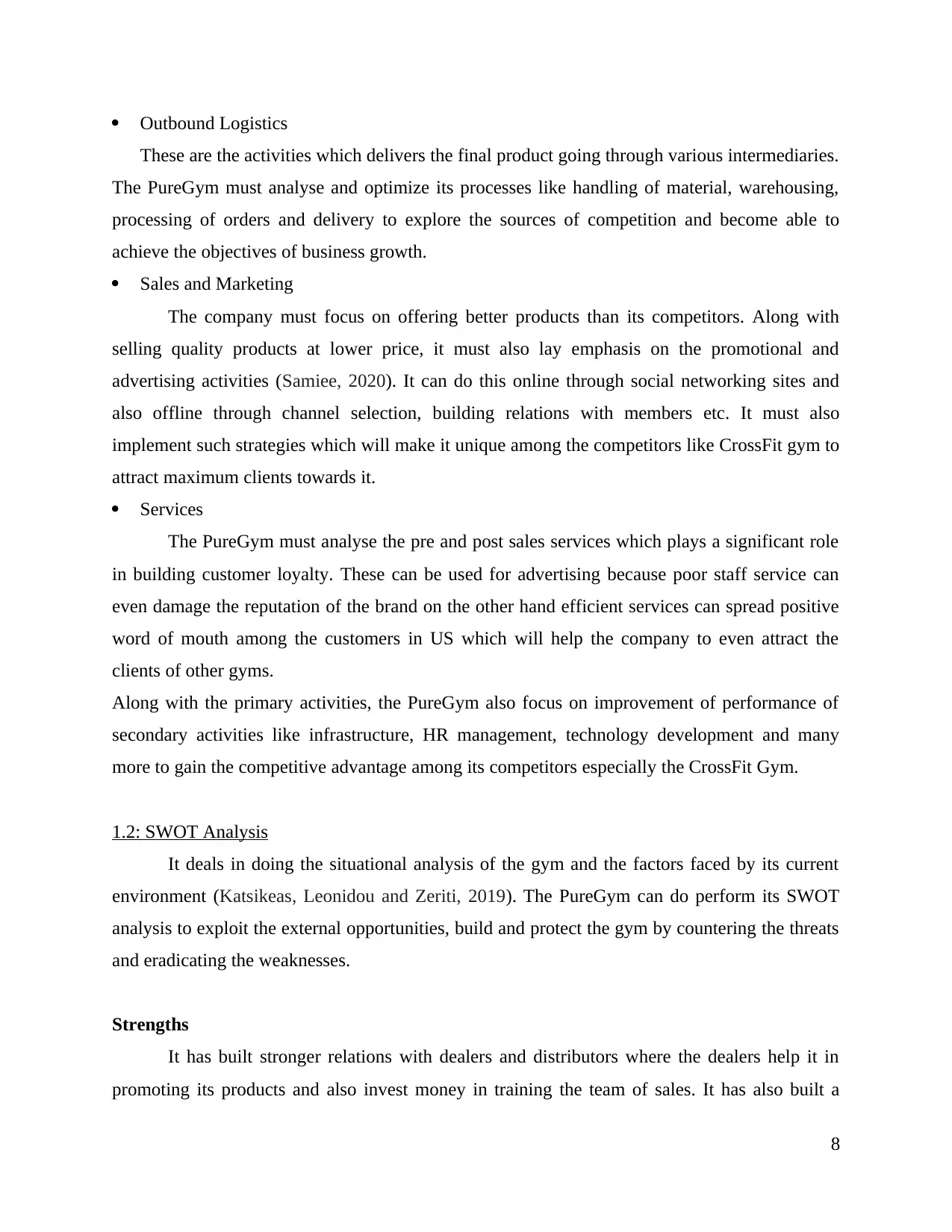
Outbound Logistics
These are the activities which delivers the final product going through various intermediaries.
The PureGym must analyse and optimize its processes like handling of material, warehousing,
processing of orders and delivery to explore the sources of competition and become able to
achieve the objectives of business growth.
Sales and Marketing
The company must focus on offering better products than its competitors. Along with
selling quality products at lower price, it must also lay emphasis on the promotional and
advertising activities (Samiee, 2020). It can do this online through social networking sites and
also offline through channel selection, building relations with members etc. It must also
implement such strategies which will make it unique among the competitors like CrossFit gym to
attract maximum clients towards it.
Services
The PureGym must analyse the pre and post sales services which plays a significant role
in building customer loyalty. These can be used for advertising because poor staff service can
even damage the reputation of the brand on the other hand efficient services can spread positive
word of mouth among the customers in US which will help the company to even attract the
clients of other gyms.
Along with the primary activities, the PureGym also focus on improvement of performance of
secondary activities like infrastructure, HR management, technology development and many
more to gain the competitive advantage among its competitors especially the CrossFit Gym.
1.2: SWOT Analysis
It deals in doing the situational analysis of the gym and the factors faced by its current
environment (Katsikeas, Leonidou and Zeriti, 2019). The PureGym can do perform its SWOT
analysis to exploit the external opportunities, build and protect the gym by countering the threats
and eradicating the weaknesses.
Strengths
It has built stronger relations with dealers and distributors where the dealers help it in
promoting its products and also invest money in training the team of sales. It has also built a
8
These are the activities which delivers the final product going through various intermediaries.
The PureGym must analyse and optimize its processes like handling of material, warehousing,
processing of orders and delivery to explore the sources of competition and become able to
achieve the objectives of business growth.
Sales and Marketing
The company must focus on offering better products than its competitors. Along with
selling quality products at lower price, it must also lay emphasis on the promotional and
advertising activities (Samiee, 2020). It can do this online through social networking sites and
also offline through channel selection, building relations with members etc. It must also
implement such strategies which will make it unique among the competitors like CrossFit gym to
attract maximum clients towards it.
Services
The PureGym must analyse the pre and post sales services which plays a significant role
in building customer loyalty. These can be used for advertising because poor staff service can
even damage the reputation of the brand on the other hand efficient services can spread positive
word of mouth among the customers in US which will help the company to even attract the
clients of other gyms.
Along with the primary activities, the PureGym also focus on improvement of performance of
secondary activities like infrastructure, HR management, technology development and many
more to gain the competitive advantage among its competitors especially the CrossFit Gym.
1.2: SWOT Analysis
It deals in doing the situational analysis of the gym and the factors faced by its current
environment (Katsikeas, Leonidou and Zeriti, 2019). The PureGym can do perform its SWOT
analysis to exploit the external opportunities, build and protect the gym by countering the threats
and eradicating the weaknesses.
Strengths
It has built stronger relations with dealers and distributors where the dealers help it in
promoting its products and also invest money in training the team of sales. It has also built a
8
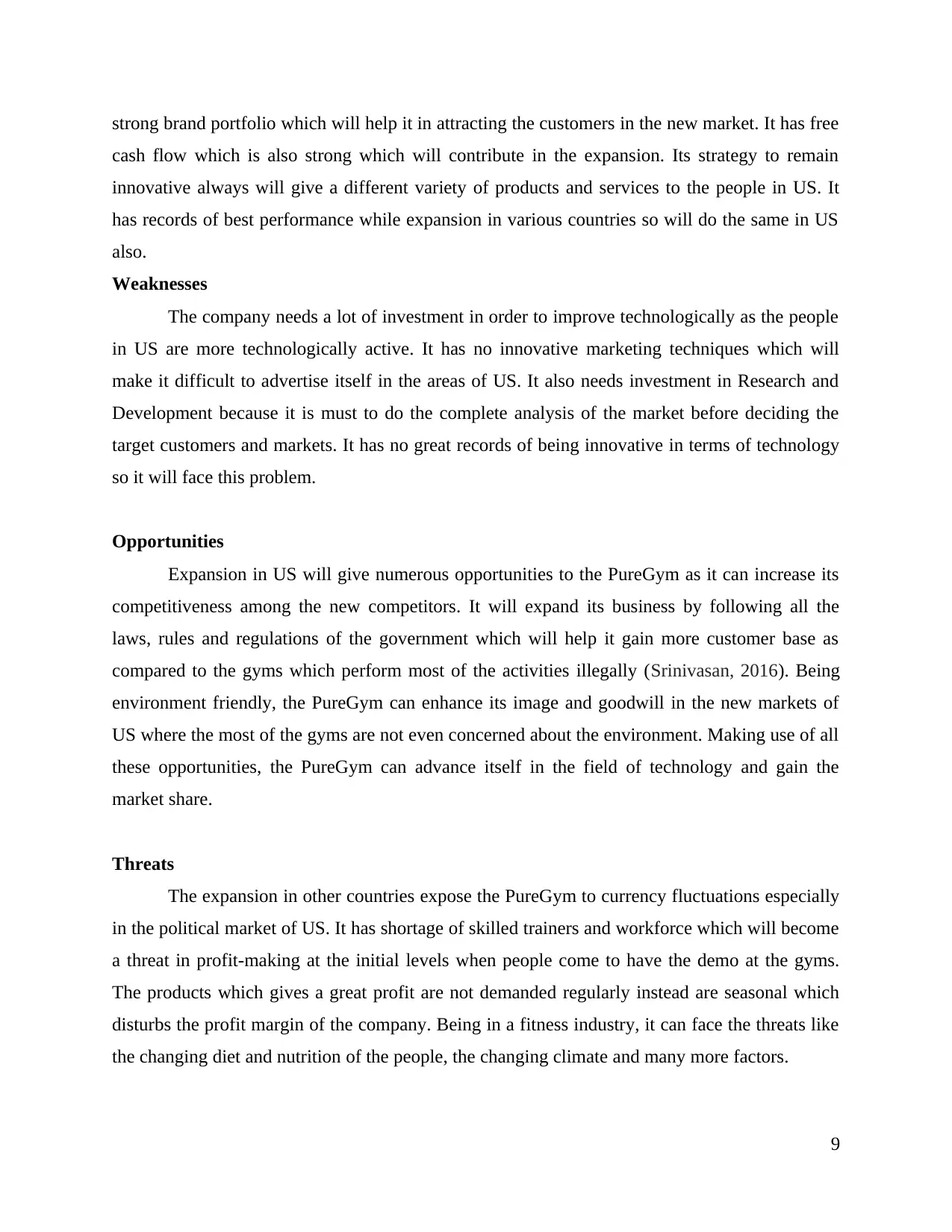
strong brand portfolio which will help it in attracting the customers in the new market. It has free
cash flow which is also strong which will contribute in the expansion. Its strategy to remain
innovative always will give a different variety of products and services to the people in US. It
has records of best performance while expansion in various countries so will do the same in US
also.
Weaknesses
The company needs a lot of investment in order to improve technologically as the people
in US are more technologically active. It has no innovative marketing techniques which will
make it difficult to advertise itself in the areas of US. It also needs investment in Research and
Development because it is must to do the complete analysis of the market before deciding the
target customers and markets. It has no great records of being innovative in terms of technology
so it will face this problem.
Opportunities
Expansion in US will give numerous opportunities to the PureGym as it can increase its
competitiveness among the new competitors. It will expand its business by following all the
laws, rules and regulations of the government which will help it gain more customer base as
compared to the gyms which perform most of the activities illegally (Srinivasan, 2016). Being
environment friendly, the PureGym can enhance its image and goodwill in the new markets of
US where the most of the gyms are not even concerned about the environment. Making use of all
these opportunities, the PureGym can advance itself in the field of technology and gain the
market share.
Threats
The expansion in other countries expose the PureGym to currency fluctuations especially
in the political market of US. It has shortage of skilled trainers and workforce which will become
a threat in profit-making at the initial levels when people come to have the demo at the gyms.
The products which gives a great profit are not demanded regularly instead are seasonal which
disturbs the profit margin of the company. Being in a fitness industry, it can face the threats like
the changing diet and nutrition of the people, the changing climate and many more factors.
9
cash flow which is also strong which will contribute in the expansion. Its strategy to remain
innovative always will give a different variety of products and services to the people in US. It
has records of best performance while expansion in various countries so will do the same in US
also.
Weaknesses
The company needs a lot of investment in order to improve technologically as the people
in US are more technologically active. It has no innovative marketing techniques which will
make it difficult to advertise itself in the areas of US. It also needs investment in Research and
Development because it is must to do the complete analysis of the market before deciding the
target customers and markets. It has no great records of being innovative in terms of technology
so it will face this problem.
Opportunities
Expansion in US will give numerous opportunities to the PureGym as it can increase its
competitiveness among the new competitors. It will expand its business by following all the
laws, rules and regulations of the government which will help it gain more customer base as
compared to the gyms which perform most of the activities illegally (Srinivasan, 2016). Being
environment friendly, the PureGym can enhance its image and goodwill in the new markets of
US where the most of the gyms are not even concerned about the environment. Making use of all
these opportunities, the PureGym can advance itself in the field of technology and gain the
market share.
Threats
The expansion in other countries expose the PureGym to currency fluctuations especially
in the political market of US. It has shortage of skilled trainers and workforce which will become
a threat in profit-making at the initial levels when people come to have the demo at the gyms.
The products which gives a great profit are not demanded regularly instead are seasonal which
disturbs the profit margin of the company. Being in a fitness industry, it can face the threats like
the changing diet and nutrition of the people, the changing climate and many more factors.
9
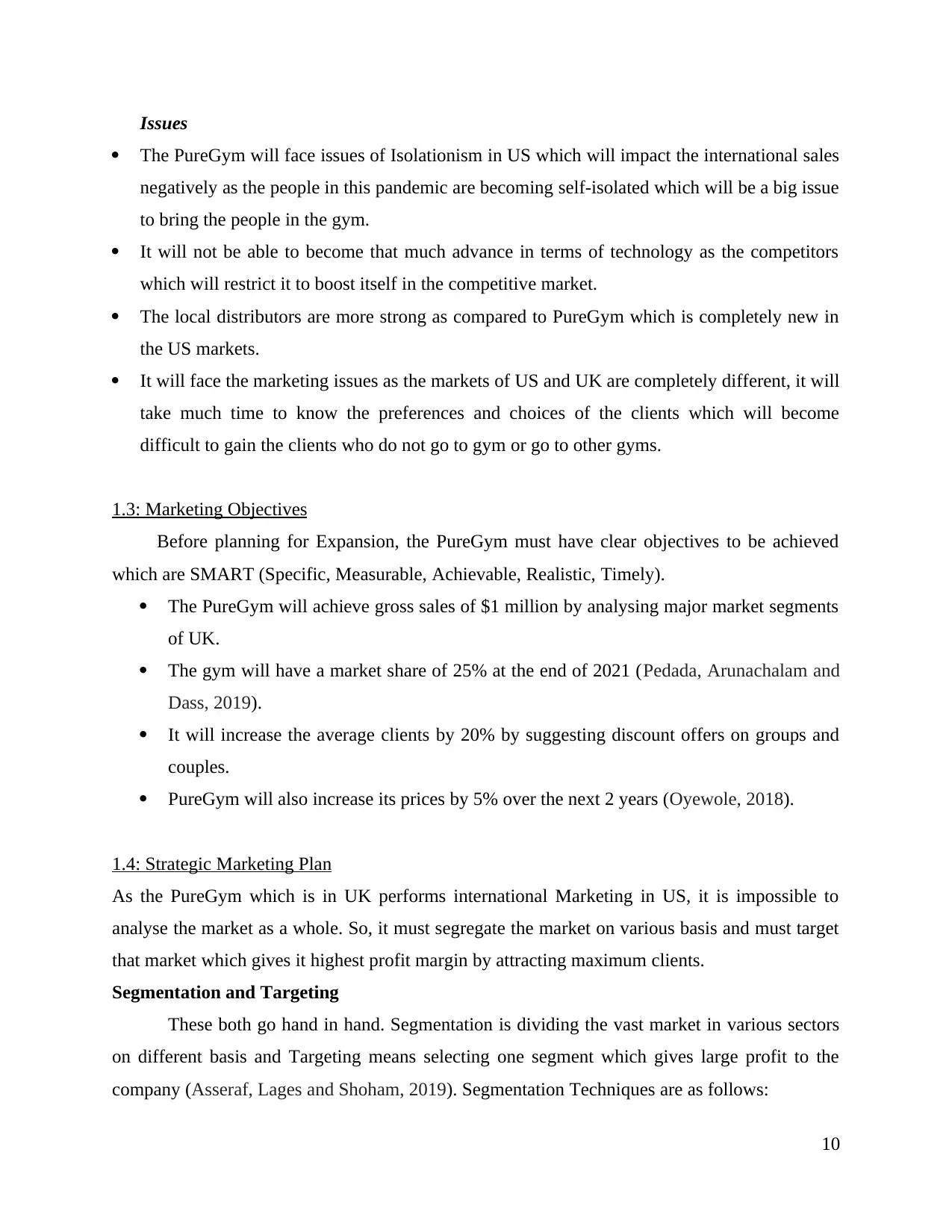
Issues
The PureGym will face issues of Isolationism in US which will impact the international sales
negatively as the people in this pandemic are becoming self-isolated which will be a big issue
to bring the people in the gym.
It will not be able to become that much advance in terms of technology as the competitors
which will restrict it to boost itself in the competitive market.
The local distributors are more strong as compared to PureGym which is completely new in
the US markets.
It will face the marketing issues as the markets of US and UK are completely different, it will
take much time to know the preferences and choices of the clients which will become
difficult to gain the clients who do not go to gym or go to other gyms.
1.3: Marketing Objectives
Before planning for Expansion, the PureGym must have clear objectives to be achieved
which are SMART (Specific, Measurable, Achievable, Realistic, Timely).
The PureGym will achieve gross sales of $1 million by analysing major market segments
of UK.
The gym will have a market share of 25% at the end of 2021 (Pedada, Arunachalam and
Dass, 2019).
It will increase the average clients by 20% by suggesting discount offers on groups and
couples.
PureGym will also increase its prices by 5% over the next 2 years (Oyewole, 2018).
1.4: Strategic Marketing Plan
As the PureGym which is in UK performs international Marketing in US, it is impossible to
analyse the market as a whole. So, it must segregate the market on various basis and must target
that market which gives it highest profit margin by attracting maximum clients.
Segmentation and Targeting
These both go hand in hand. Segmentation is dividing the vast market in various sectors
on different basis and Targeting means selecting one segment which gives large profit to the
company (Asseraf, Lages and Shoham, 2019). Segmentation Techniques are as follows:
10
The PureGym will face issues of Isolationism in US which will impact the international sales
negatively as the people in this pandemic are becoming self-isolated which will be a big issue
to bring the people in the gym.
It will not be able to become that much advance in terms of technology as the competitors
which will restrict it to boost itself in the competitive market.
The local distributors are more strong as compared to PureGym which is completely new in
the US markets.
It will face the marketing issues as the markets of US and UK are completely different, it will
take much time to know the preferences and choices of the clients which will become
difficult to gain the clients who do not go to gym or go to other gyms.
1.3: Marketing Objectives
Before planning for Expansion, the PureGym must have clear objectives to be achieved
which are SMART (Specific, Measurable, Achievable, Realistic, Timely).
The PureGym will achieve gross sales of $1 million by analysing major market segments
of UK.
The gym will have a market share of 25% at the end of 2021 (Pedada, Arunachalam and
Dass, 2019).
It will increase the average clients by 20% by suggesting discount offers on groups and
couples.
PureGym will also increase its prices by 5% over the next 2 years (Oyewole, 2018).
1.4: Strategic Marketing Plan
As the PureGym which is in UK performs international Marketing in US, it is impossible to
analyse the market as a whole. So, it must segregate the market on various basis and must target
that market which gives it highest profit margin by attracting maximum clients.
Segmentation and Targeting
These both go hand in hand. Segmentation is dividing the vast market in various sectors
on different basis and Targeting means selecting one segment which gives large profit to the
company (Asseraf, Lages and Shoham, 2019). Segmentation Techniques are as follows:
10
Secure Best Marks with AI Grader
Need help grading? Try our AI Grader for instant feedback on your assignments.

Demographics: These are on the basis of gender, age, education, income etc.
Geographic: These based on countries, culture, rural v/s urban etc.
Psychological: This segment is based on attitudes, knowledge, awareness, needs and demands of
the customers etc.
Behaviours: This is based on the users of a brand, co-purchase patterns etc.
The PureGym must target the Demographics segment because the gym is mainly concerned with
the gender, age and income. Lower class people cannot afford gyms. The people of age group
18-30 mostly prefer gyms.
Positioning
It describes how the gym portrays its products and services in the market. It must portray
as itself as an innovator which does not get afraid with the changing demands of the people. It
can innovate in terms of technology, machines, fitness diet, nutrition etc.
So, the PureGym must segment, target and position itself after doing a complete research of the
marker as well as its own analysis to gain a competitive advantage in the markets of US and
enhance its overall profitability by increasing its client base.
1.5: Marketing Tactics
Marketing tactics refer to the strategic actions which will direct the promotional
strategies of PureGym in order to influence target marketing goals. It describes three components
of the marketing architecture, mainly marketing mix, differentiation and selling (Kartajaya,
Kotler and Hooi, 2019). The tactics can be either traditional or digital and will be explained by
application of the Lauterborn’s model of 4C. This model is based on a more customer centric
approach than of the traditional P’s of marketing mix.
Consumer wants and needs: This corresponds to the product and services of PureGym.
The people want access to the various exercise contraptions (generally of a specific
period) and gym equipment along with fitness lessons, training, guidance from certified
& specialised fitness coaches. Majority of gym branches are open 24 hours a day and
provide complete range of updated cardio fitness machines, fixed-resistance and weights.
Along with this, members have access to around 50 group classes every week.
11
Geographic: These based on countries, culture, rural v/s urban etc.
Psychological: This segment is based on attitudes, knowledge, awareness, needs and demands of
the customers etc.
Behaviours: This is based on the users of a brand, co-purchase patterns etc.
The PureGym must target the Demographics segment because the gym is mainly concerned with
the gender, age and income. Lower class people cannot afford gyms. The people of age group
18-30 mostly prefer gyms.
Positioning
It describes how the gym portrays its products and services in the market. It must portray
as itself as an innovator which does not get afraid with the changing demands of the people. It
can innovate in terms of technology, machines, fitness diet, nutrition etc.
So, the PureGym must segment, target and position itself after doing a complete research of the
marker as well as its own analysis to gain a competitive advantage in the markets of US and
enhance its overall profitability by increasing its client base.
1.5: Marketing Tactics
Marketing tactics refer to the strategic actions which will direct the promotional
strategies of PureGym in order to influence target marketing goals. It describes three components
of the marketing architecture, mainly marketing mix, differentiation and selling (Kartajaya,
Kotler and Hooi, 2019). The tactics can be either traditional or digital and will be explained by
application of the Lauterborn’s model of 4C. This model is based on a more customer centric
approach than of the traditional P’s of marketing mix.
Consumer wants and needs: This corresponds to the product and services of PureGym.
The people want access to the various exercise contraptions (generally of a specific
period) and gym equipment along with fitness lessons, training, guidance from certified
& specialised fitness coaches. Majority of gym branches are open 24 hours a day and
provide complete range of updated cardio fitness machines, fixed-resistance and weights.
Along with this, members have access to around 50 group classes every week.
11
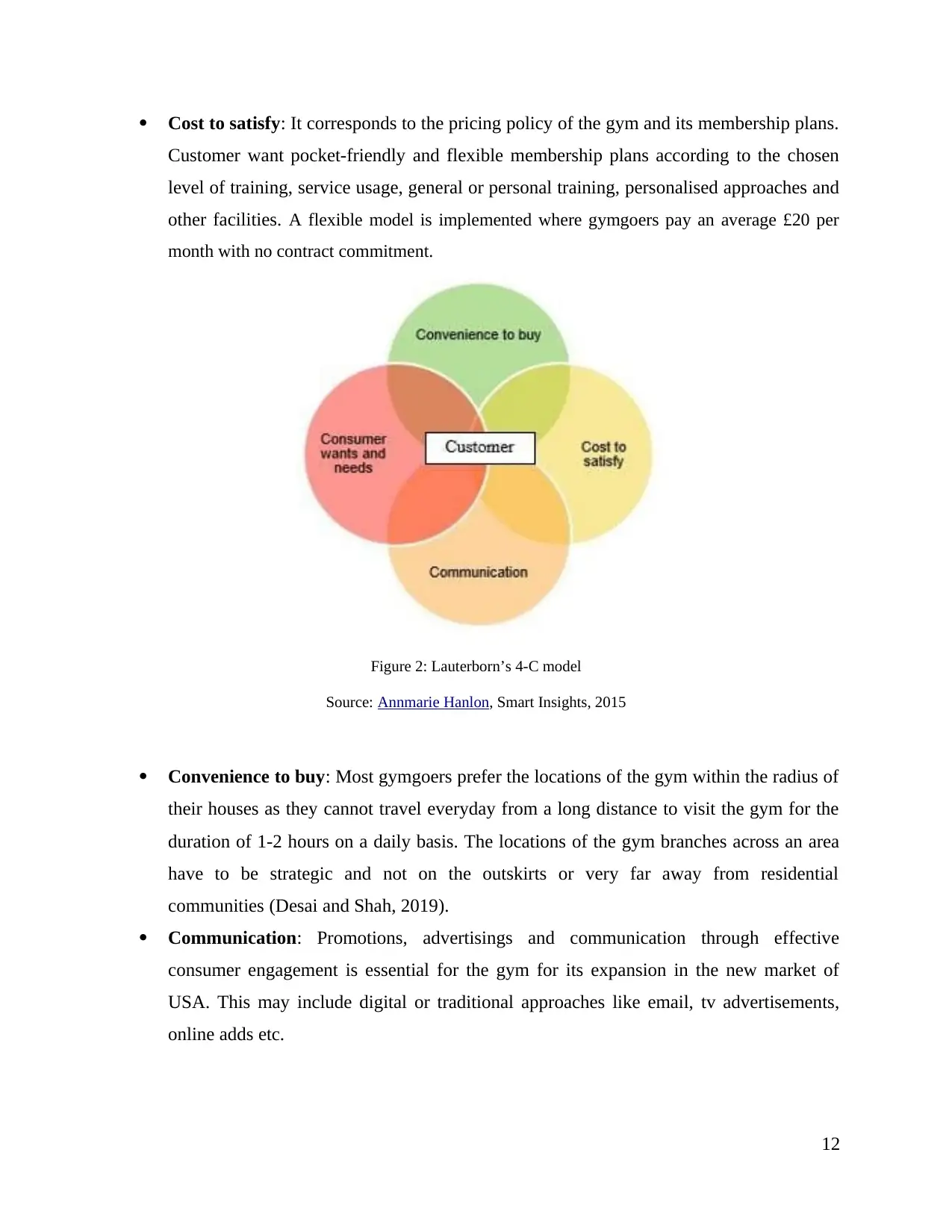
Cost to satisfy: It corresponds to the pricing policy of the gym and its membership plans.
Customer want pocket-friendly and flexible membership plans according to the chosen
level of training, service usage, general or personal training, personalised approaches and
other facilities. A flexible model is implemented where gymgoers pay an average £20 per
month with no contract commitment.
Figure 2: Lauterborn’s 4-C model
Source: Annmarie Hanlon, Smart Insights, 2015
Convenience to buy: Most gymgoers prefer the locations of the gym within the radius of
their houses as they cannot travel everyday from a long distance to visit the gym for the
duration of 1-2 hours on a daily basis. The locations of the gym branches across an area
have to be strategic and not on the outskirts or very far away from residential
communities (Desai and Shah, 2019).
Communication: Promotions, advertisings and communication through effective
consumer engagement is essential for the gym for its expansion in the new market of
USA. This may include digital or traditional approaches like email, tv advertisements,
online adds etc.
12
Customer want pocket-friendly and flexible membership plans according to the chosen
level of training, service usage, general or personal training, personalised approaches and
other facilities. A flexible model is implemented where gymgoers pay an average £20 per
month with no contract commitment.
Figure 2: Lauterborn’s 4-C model
Source: Annmarie Hanlon, Smart Insights, 2015
Convenience to buy: Most gymgoers prefer the locations of the gym within the radius of
their houses as they cannot travel everyday from a long distance to visit the gym for the
duration of 1-2 hours on a daily basis. The locations of the gym branches across an area
have to be strategic and not on the outskirts or very far away from residential
communities (Desai and Shah, 2019).
Communication: Promotions, advertisings and communication through effective
consumer engagement is essential for the gym for its expansion in the new market of
USA. This may include digital or traditional approaches like email, tv advertisements,
online adds etc.
12
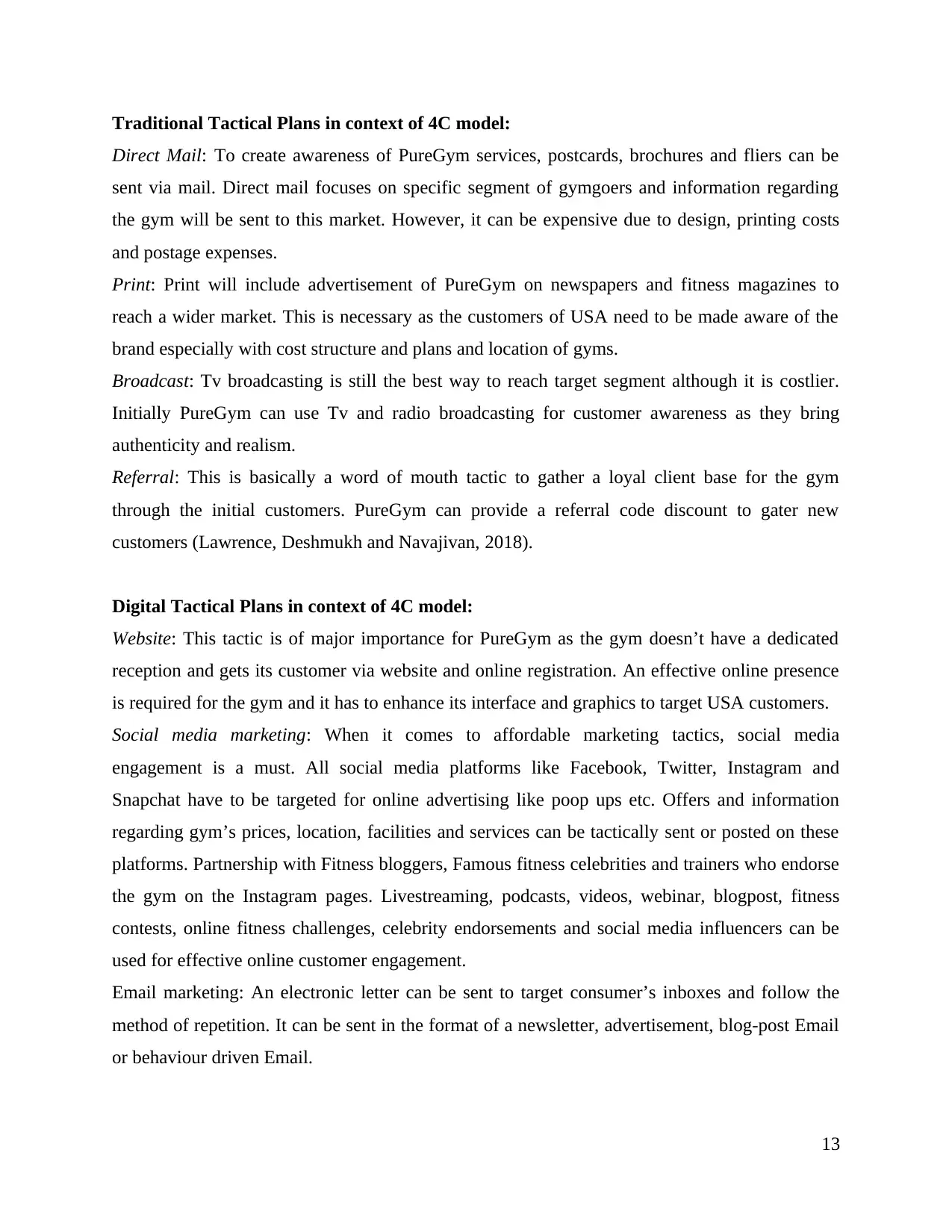
Traditional Tactical Plans in context of 4C model:
Direct Mail: To create awareness of PureGym services, postcards, brochures and fliers can be
sent via mail. Direct mail focuses on specific segment of gymgoers and information regarding
the gym will be sent to this market. However, it can be expensive due to design, printing costs
and postage expenses.
Print: Print will include advertisement of PureGym on newspapers and fitness magazines to
reach a wider market. This is necessary as the customers of USA need to be made aware of the
brand especially with cost structure and plans and location of gyms.
Broadcast: Tv broadcasting is still the best way to reach target segment although it is costlier.
Initially PureGym can use Tv and radio broadcasting for customer awareness as they bring
authenticity and realism.
Referral: This is basically a word of mouth tactic to gather a loyal client base for the gym
through the initial customers. PureGym can provide a referral code discount to gater new
customers (Lawrence, Deshmukh and Navajivan, 2018).
Digital Tactical Plans in context of 4C model:
Website: This tactic is of major importance for PureGym as the gym doesn’t have a dedicated
reception and gets its customer via website and online registration. An effective online presence
is required for the gym and it has to enhance its interface and graphics to target USA customers.
Social media marketing: When it comes to affordable marketing tactics, social media
engagement is a must. All social media platforms like Facebook, Twitter, Instagram and
Snapchat have to be targeted for online advertising like poop ups etc. Offers and information
regarding gym’s prices, location, facilities and services can be tactically sent or posted on these
platforms. Partnership with Fitness bloggers, Famous fitness celebrities and trainers who endorse
the gym on the Instagram pages. Livestreaming, podcasts, videos, webinar, blogpost, fitness
contests, online fitness challenges, celebrity endorsements and social media influencers can be
used for effective online customer engagement.
Email marketing: An electronic letter can be sent to target consumer’s inboxes and follow the
method of repetition. It can be sent in the format of a newsletter, advertisement, blog-post Email
or behaviour driven Email.
13
Direct Mail: To create awareness of PureGym services, postcards, brochures and fliers can be
sent via mail. Direct mail focuses on specific segment of gymgoers and information regarding
the gym will be sent to this market. However, it can be expensive due to design, printing costs
and postage expenses.
Print: Print will include advertisement of PureGym on newspapers and fitness magazines to
reach a wider market. This is necessary as the customers of USA need to be made aware of the
brand especially with cost structure and plans and location of gyms.
Broadcast: Tv broadcasting is still the best way to reach target segment although it is costlier.
Initially PureGym can use Tv and radio broadcasting for customer awareness as they bring
authenticity and realism.
Referral: This is basically a word of mouth tactic to gather a loyal client base for the gym
through the initial customers. PureGym can provide a referral code discount to gater new
customers (Lawrence, Deshmukh and Navajivan, 2018).
Digital Tactical Plans in context of 4C model:
Website: This tactic is of major importance for PureGym as the gym doesn’t have a dedicated
reception and gets its customer via website and online registration. An effective online presence
is required for the gym and it has to enhance its interface and graphics to target USA customers.
Social media marketing: When it comes to affordable marketing tactics, social media
engagement is a must. All social media platforms like Facebook, Twitter, Instagram and
Snapchat have to be targeted for online advertising like poop ups etc. Offers and information
regarding gym’s prices, location, facilities and services can be tactically sent or posted on these
platforms. Partnership with Fitness bloggers, Famous fitness celebrities and trainers who endorse
the gym on the Instagram pages. Livestreaming, podcasts, videos, webinar, blogpost, fitness
contests, online fitness challenges, celebrity endorsements and social media influencers can be
used for effective online customer engagement.
Email marketing: An electronic letter can be sent to target consumer’s inboxes and follow the
method of repetition. It can be sent in the format of a newsletter, advertisement, blog-post Email
or behaviour driven Email.
13
Paraphrase This Document
Need a fresh take? Get an instant paraphrase of this document with our AI Paraphraser
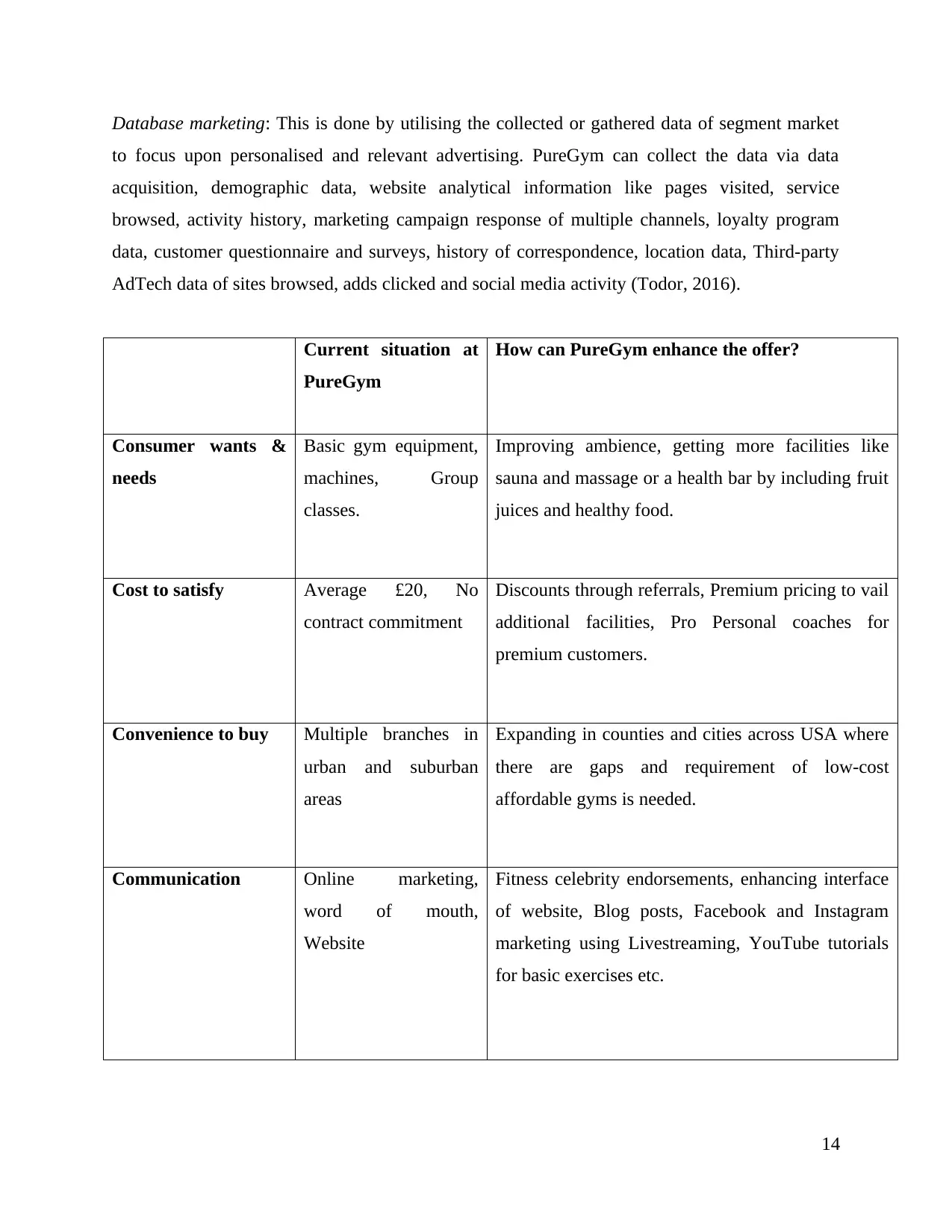
Database marketing: This is done by utilising the collected or gathered data of segment market
to focus upon personalised and relevant advertising. PureGym can collect the data via data
acquisition, demographic data, website analytical information like pages visited, service
browsed, activity history, marketing campaign response of multiple channels, loyalty program
data, customer questionnaire and surveys, history of correspondence, location data, Third-party
AdTech data of sites browsed, adds clicked and social media activity (Todor, 2016).
Current situation at
PureGym
How can PureGym enhance the offer?
Consumer wants &
needs
Basic gym equipment,
machines, Group
classes.
Improving ambience, getting more facilities like
sauna and massage or a health bar by including fruit
juices and healthy food.
Cost to satisfy Average £20, No
contract commitment
Discounts through referrals, Premium pricing to vail
additional facilities, Pro Personal coaches for
premium customers.
Convenience to buy Multiple branches in
urban and suburban
areas
Expanding in counties and cities across USA where
there are gaps and requirement of low-cost
affordable gyms is needed.
Communication Online marketing,
word of mouth,
Website
Fitness celebrity endorsements, enhancing interface
of website, Blog posts, Facebook and Instagram
marketing using Livestreaming, YouTube tutorials
for basic exercises etc.
14
to focus upon personalised and relevant advertising. PureGym can collect the data via data
acquisition, demographic data, website analytical information like pages visited, service
browsed, activity history, marketing campaign response of multiple channels, loyalty program
data, customer questionnaire and surveys, history of correspondence, location data, Third-party
AdTech data of sites browsed, adds clicked and social media activity (Todor, 2016).
Current situation at
PureGym
How can PureGym enhance the offer?
Consumer wants &
needs
Basic gym equipment,
machines, Group
classes.
Improving ambience, getting more facilities like
sauna and massage or a health bar by including fruit
juices and healthy food.
Cost to satisfy Average £20, No
contract commitment
Discounts through referrals, Premium pricing to vail
additional facilities, Pro Personal coaches for
premium customers.
Convenience to buy Multiple branches in
urban and suburban
areas
Expanding in counties and cities across USA where
there are gaps and requirement of low-cost
affordable gyms is needed.
Communication Online marketing,
word of mouth,
Website
Fitness celebrity endorsements, enhancing interface
of website, Blog posts, Facebook and Instagram
marketing using Livestreaming, YouTube tutorials
for basic exercises etc.
14

1.6: Action Plan, Budgets and Financials
According to the financial statements obtained for the company, i.e. PureGym, the cash and cash
equivalents amounted to £65,589 for year ended 2019. Assuming Net cash flow for operating
activities, the Marketing campaign can be budgeted at an estimate of around £28,000. The
estimated timescale is 3 years while the tactical timeline is considered as a period of 12 months.
The estimated cost of each activity during monthly quarter from September 2020 to September
2021 has been illustrated using a Gantt chart.
Implementation of activities:
Defining gym’s target market: using demographic data and psychographic data of
customers of various counties of USA
15
According to the financial statements obtained for the company, i.e. PureGym, the cash and cash
equivalents amounted to £65,589 for year ended 2019. Assuming Net cash flow for operating
activities, the Marketing campaign can be budgeted at an estimate of around £28,000. The
estimated timescale is 3 years while the tactical timeline is considered as a period of 12 months.
The estimated cost of each activity during monthly quarter from September 2020 to September
2021 has been illustrated using a Gantt chart.
Implementation of activities:
Defining gym’s target market: using demographic data and psychographic data of
customers of various counties of USA
15
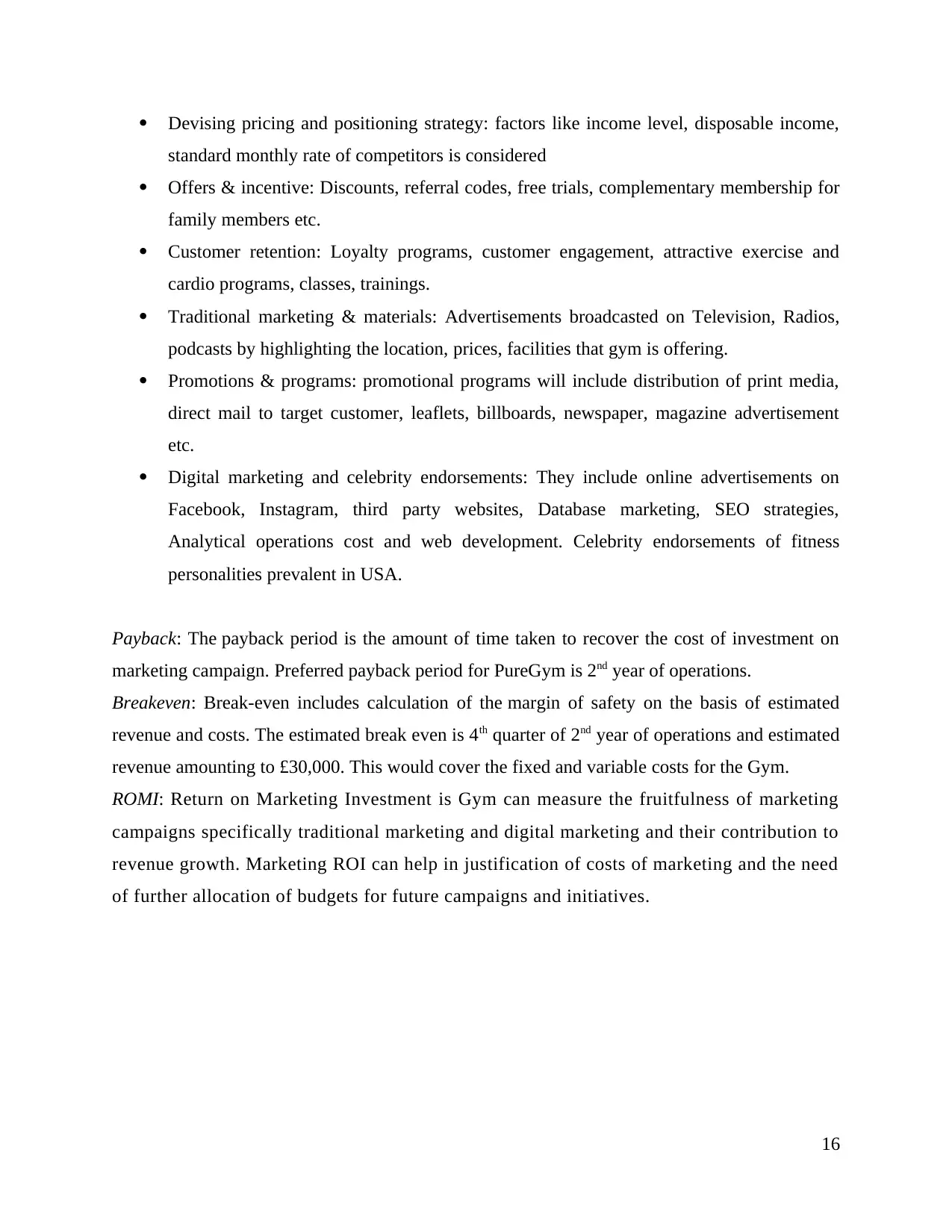
Devising pricing and positioning strategy: factors like income level, disposable income,
standard monthly rate of competitors is considered
Offers & incentive: Discounts, referral codes, free trials, complementary membership for
family members etc.
Customer retention: Loyalty programs, customer engagement, attractive exercise and
cardio programs, classes, trainings.
Traditional marketing & materials: Advertisements broadcasted on Television, Radios,
podcasts by highlighting the location, prices, facilities that gym is offering.
Promotions & programs: promotional programs will include distribution of print media,
direct mail to target customer, leaflets, billboards, newspaper, magazine advertisement
etc.
Digital marketing and celebrity endorsements: They include online advertisements on
Facebook, Instagram, third party websites, Database marketing, SEO strategies,
Analytical operations cost and web development. Celebrity endorsements of fitness
personalities prevalent in USA.
Payback: The payback period is the amount of time taken to recover the cost of investment on
marketing campaign. Preferred payback period for PureGym is 2nd year of operations.
Breakeven: Break-even includes calculation of the margin of safety on the basis of estimated
revenue and costs. The estimated break even is 4th quarter of 2nd year of operations and estimated
revenue amounting to £30,000. This would cover the fixed and variable costs for the Gym.
ROMI: Return on Marketing Investment is Gym can measure the fruitfulness of marketing
campaigns specifically traditional marketing and digital marketing and their contribution to
revenue growth. Marketing ROI can help in justification of costs of marketing and the need
of further allocation of budgets for future campaigns and initiatives.
16
standard monthly rate of competitors is considered
Offers & incentive: Discounts, referral codes, free trials, complementary membership for
family members etc.
Customer retention: Loyalty programs, customer engagement, attractive exercise and
cardio programs, classes, trainings.
Traditional marketing & materials: Advertisements broadcasted on Television, Radios,
podcasts by highlighting the location, prices, facilities that gym is offering.
Promotions & programs: promotional programs will include distribution of print media,
direct mail to target customer, leaflets, billboards, newspaper, magazine advertisement
etc.
Digital marketing and celebrity endorsements: They include online advertisements on
Facebook, Instagram, third party websites, Database marketing, SEO strategies,
Analytical operations cost and web development. Celebrity endorsements of fitness
personalities prevalent in USA.
Payback: The payback period is the amount of time taken to recover the cost of investment on
marketing campaign. Preferred payback period for PureGym is 2nd year of operations.
Breakeven: Break-even includes calculation of the margin of safety on the basis of estimated
revenue and costs. The estimated break even is 4th quarter of 2nd year of operations and estimated
revenue amounting to £30,000. This would cover the fixed and variable costs for the Gym.
ROMI: Return on Marketing Investment is Gym can measure the fruitfulness of marketing
campaigns specifically traditional marketing and digital marketing and their contribution to
revenue growth. Marketing ROI can help in justification of costs of marketing and the need
of further allocation of budgets for future campaigns and initiatives.
16
Secure Best Marks with AI Grader
Need help grading? Try our AI Grader for instant feedback on your assignments.
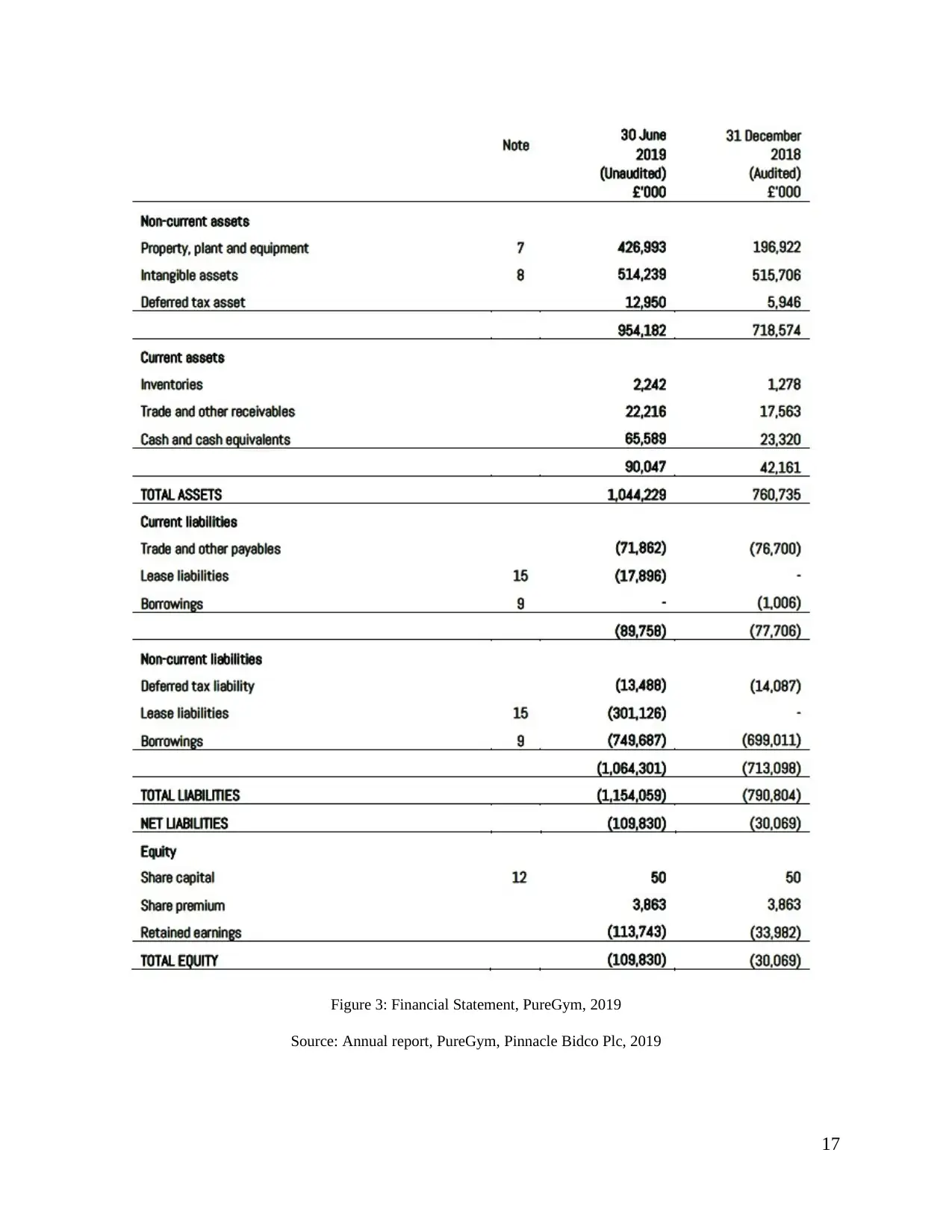
Figure 3: Financial Statement, PureGym, 2019
Source: Annual report, PureGym, Pinnacle Bidco Plc, 2019
17
Source: Annual report, PureGym, Pinnacle Bidco Plc, 2019
17
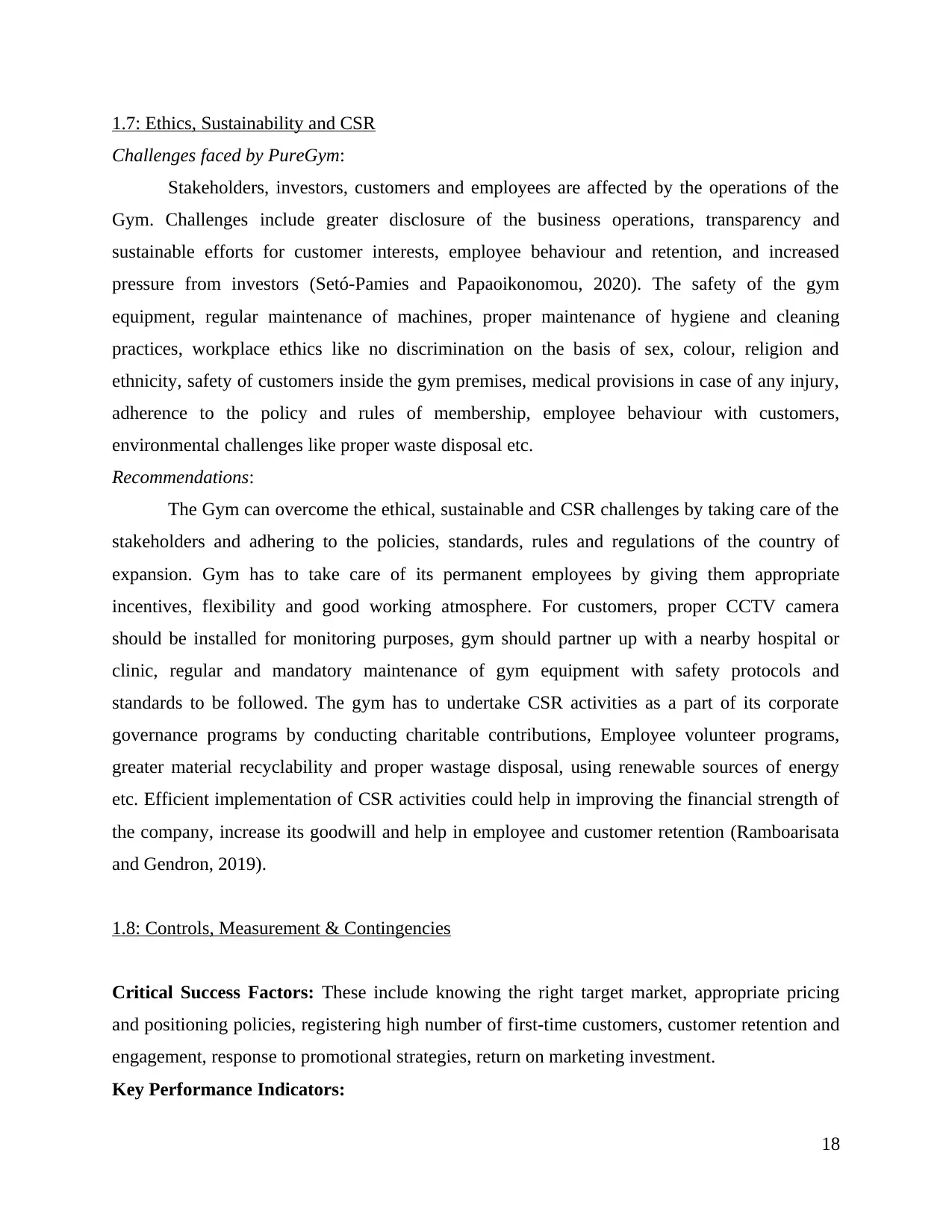
1.7: Ethics, Sustainability and CSR
Challenges faced by PureGym:
Stakeholders, investors, customers and employees are affected by the operations of the
Gym. Challenges include greater disclosure of the business operations, transparency and
sustainable efforts for customer interests, employee behaviour and retention, and increased
pressure from investors (Setó-Pamies and Papaoikonomou, 2020). The safety of the gym
equipment, regular maintenance of machines, proper maintenance of hygiene and cleaning
practices, workplace ethics like no discrimination on the basis of sex, colour, religion and
ethnicity, safety of customers inside the gym premises, medical provisions in case of any injury,
adherence to the policy and rules of membership, employee behaviour with customers,
environmental challenges like proper waste disposal etc.
Recommendations:
The Gym can overcome the ethical, sustainable and CSR challenges by taking care of the
stakeholders and adhering to the policies, standards, rules and regulations of the country of
expansion. Gym has to take care of its permanent employees by giving them appropriate
incentives, flexibility and good working atmosphere. For customers, proper CCTV camera
should be installed for monitoring purposes, gym should partner up with a nearby hospital or
clinic, regular and mandatory maintenance of gym equipment with safety protocols and
standards to be followed. The gym has to undertake CSR activities as a part of its corporate
governance programs by conducting charitable contributions, Employee volunteer programs,
greater material recyclability and proper wastage disposal, using renewable sources of energy
etc. Efficient implementation of CSR activities could help in improving the financial strength of
the company, increase its goodwill and help in employee and customer retention (Ramboarisata
and Gendron, 2019).
1.8: Controls, Measurement & Contingencies
Critical Success Factors: These include knowing the right target market, appropriate pricing
and positioning policies, registering high number of first-time customers, customer retention and
engagement, response to promotional strategies, return on marketing investment.
Key Performance Indicators:
18
Challenges faced by PureGym:
Stakeholders, investors, customers and employees are affected by the operations of the
Gym. Challenges include greater disclosure of the business operations, transparency and
sustainable efforts for customer interests, employee behaviour and retention, and increased
pressure from investors (Setó-Pamies and Papaoikonomou, 2020). The safety of the gym
equipment, regular maintenance of machines, proper maintenance of hygiene and cleaning
practices, workplace ethics like no discrimination on the basis of sex, colour, religion and
ethnicity, safety of customers inside the gym premises, medical provisions in case of any injury,
adherence to the policy and rules of membership, employee behaviour with customers,
environmental challenges like proper waste disposal etc.
Recommendations:
The Gym can overcome the ethical, sustainable and CSR challenges by taking care of the
stakeholders and adhering to the policies, standards, rules and regulations of the country of
expansion. Gym has to take care of its permanent employees by giving them appropriate
incentives, flexibility and good working atmosphere. For customers, proper CCTV camera
should be installed for monitoring purposes, gym should partner up with a nearby hospital or
clinic, regular and mandatory maintenance of gym equipment with safety protocols and
standards to be followed. The gym has to undertake CSR activities as a part of its corporate
governance programs by conducting charitable contributions, Employee volunteer programs,
greater material recyclability and proper wastage disposal, using renewable sources of energy
etc. Efficient implementation of CSR activities could help in improving the financial strength of
the company, increase its goodwill and help in employee and customer retention (Ramboarisata
and Gendron, 2019).
1.8: Controls, Measurement & Contingencies
Critical Success Factors: These include knowing the right target market, appropriate pricing
and positioning policies, registering high number of first-time customers, customer retention and
engagement, response to promotional strategies, return on marketing investment.
Key Performance Indicators:
18
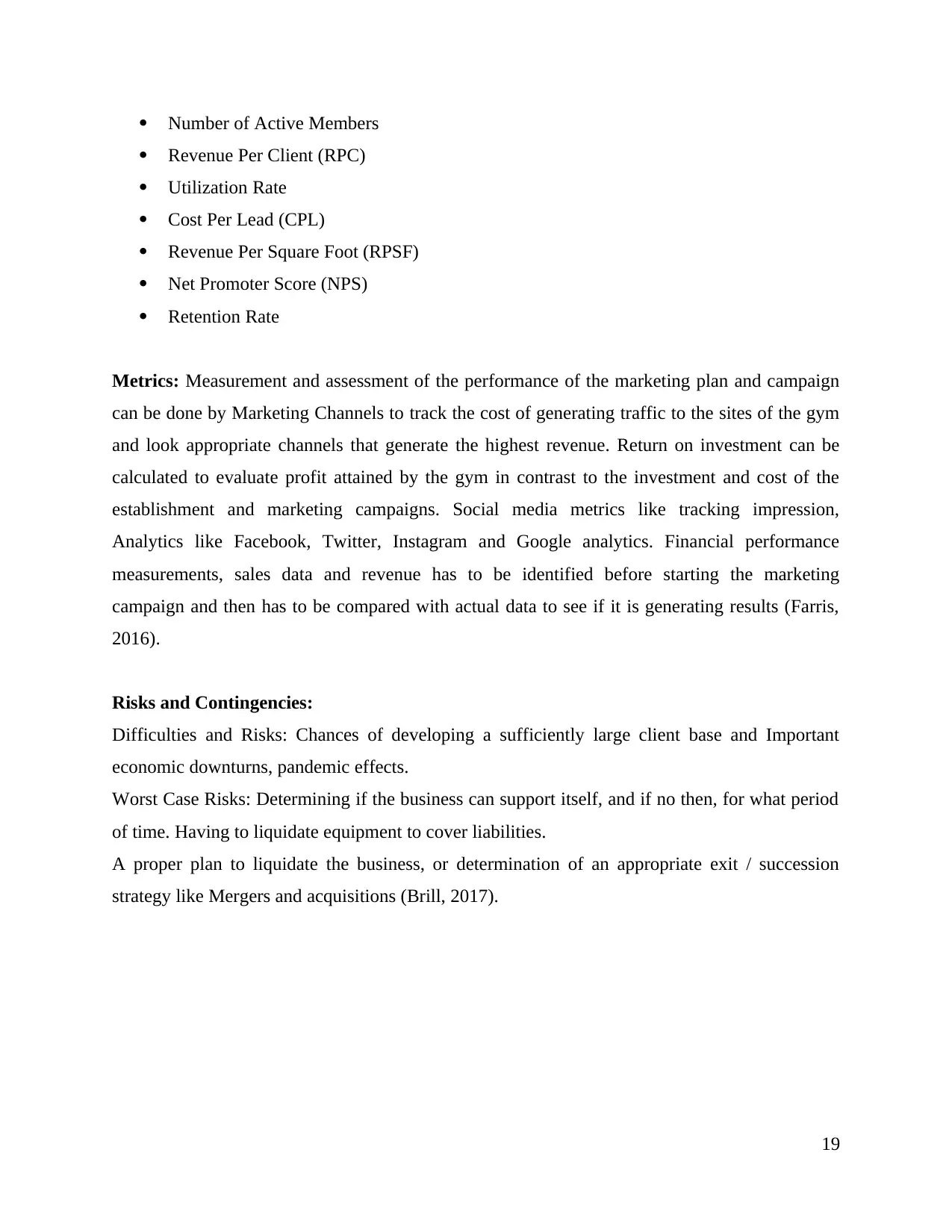
Number of Active Members
Revenue Per Client (RPC)
Utilization Rate
Cost Per Lead (CPL)
Revenue Per Square Foot (RPSF)
Net Promoter Score (NPS)
Retention Rate
Metrics: Measurement and assessment of the performance of the marketing plan and campaign
can be done by Marketing Channels to track the cost of generating traffic to the sites of the gym
and look appropriate channels that generate the highest revenue. Return on investment can be
calculated to evaluate profit attained by the gym in contrast to the investment and cost of the
establishment and marketing campaigns. Social media metrics like tracking impression,
Analytics like Facebook, Twitter, Instagram and Google analytics. Financial performance
measurements, sales data and revenue has to be identified before starting the marketing
campaign and then has to be compared with actual data to see if it is generating results (Farris,
2016).
Risks and Contingencies:
Difficulties and Risks: Chances of developing a sufficiently large client base and Important
economic downturns, pandemic effects.
Worst Case Risks: Determining if the business can support itself, and if no then, for what period
of time. Having to liquidate equipment to cover liabilities.
A proper plan to liquidate the business, or determination of an appropriate exit / succession
strategy like Mergers and acquisitions (Brill, 2017).
19
Revenue Per Client (RPC)
Utilization Rate
Cost Per Lead (CPL)
Revenue Per Square Foot (RPSF)
Net Promoter Score (NPS)
Retention Rate
Metrics: Measurement and assessment of the performance of the marketing plan and campaign
can be done by Marketing Channels to track the cost of generating traffic to the sites of the gym
and look appropriate channels that generate the highest revenue. Return on investment can be
calculated to evaluate profit attained by the gym in contrast to the investment and cost of the
establishment and marketing campaigns. Social media metrics like tracking impression,
Analytics like Facebook, Twitter, Instagram and Google analytics. Financial performance
measurements, sales data and revenue has to be identified before starting the marketing
campaign and then has to be compared with actual data to see if it is generating results (Farris,
2016).
Risks and Contingencies:
Difficulties and Risks: Chances of developing a sufficiently large client base and Important
economic downturns, pandemic effects.
Worst Case Risks: Determining if the business can support itself, and if no then, for what period
of time. Having to liquidate equipment to cover liabilities.
A proper plan to liquidate the business, or determination of an appropriate exit / succession
strategy like Mergers and acquisitions (Brill, 2017).
19
Paraphrase This Document
Need a fresh take? Get an instant paraphrase of this document with our AI Paraphraser
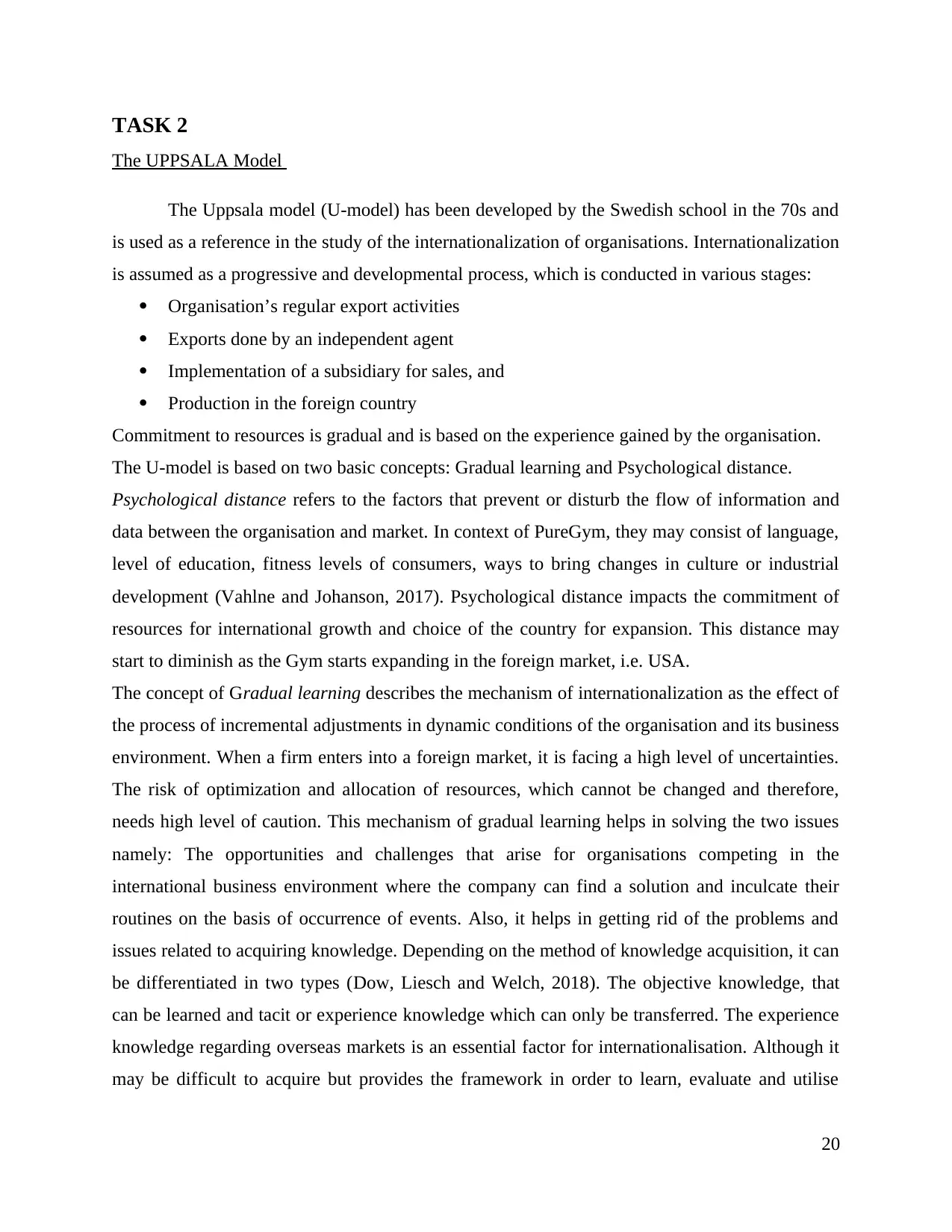
TASK 2
The UPPSALA Model
The Uppsala model (U-model) has been developed by the Swedish school in the 70s and
is used as a reference in the study of the internationalization of organisations. Internationalization
is assumed as a progressive and developmental process, which is conducted in various stages:
Organisation’s regular export activities
Exports done by an independent agent
Implementation of a subsidiary for sales, and
Production in the foreign country
Commitment to resources is gradual and is based on the experience gained by the organisation.
The U-model is based on two basic concepts: Gradual learning and Psychological distance.
Psychological distance refers to the factors that prevent or disturb the flow of information and
data between the organisation and market. In context of PureGym, they may consist of language,
level of education, fitness levels of consumers, ways to bring changes in culture or industrial
development (Vahlne and Johanson, 2017). Psychological distance impacts the commitment of
resources for international growth and choice of the country for expansion. This distance may
start to diminish as the Gym starts expanding in the foreign market, i.e. USA.
The concept of Gradual learning describes the mechanism of internationalization as the effect of
the process of incremental adjustments in dynamic conditions of the organisation and its business
environment. When a firm enters into a foreign market, it is facing a high level of uncertainties.
The risk of optimization and allocation of resources, which cannot be changed and therefore,
needs high level of caution. This mechanism of gradual learning helps in solving the two issues
namely: The opportunities and challenges that arise for organisations competing in the
international business environment where the company can find a solution and inculcate their
routines on the basis of occurrence of events. Also, it helps in getting rid of the problems and
issues related to acquiring knowledge. Depending on the method of knowledge acquisition, it can
be differentiated in two types (Dow, Liesch and Welch, 2018). The objective knowledge, that
can be learned and tacit or experience knowledge which can only be transferred. The experience
knowledge regarding overseas markets is an essential factor for internationalisation. Although it
may be difficult to acquire but provides the framework in order to learn, evaluate and utilise
20
The UPPSALA Model
The Uppsala model (U-model) has been developed by the Swedish school in the 70s and
is used as a reference in the study of the internationalization of organisations. Internationalization
is assumed as a progressive and developmental process, which is conducted in various stages:
Organisation’s regular export activities
Exports done by an independent agent
Implementation of a subsidiary for sales, and
Production in the foreign country
Commitment to resources is gradual and is based on the experience gained by the organisation.
The U-model is based on two basic concepts: Gradual learning and Psychological distance.
Psychological distance refers to the factors that prevent or disturb the flow of information and
data between the organisation and market. In context of PureGym, they may consist of language,
level of education, fitness levels of consumers, ways to bring changes in culture or industrial
development (Vahlne and Johanson, 2017). Psychological distance impacts the commitment of
resources for international growth and choice of the country for expansion. This distance may
start to diminish as the Gym starts expanding in the foreign market, i.e. USA.
The concept of Gradual learning describes the mechanism of internationalization as the effect of
the process of incremental adjustments in dynamic conditions of the organisation and its business
environment. When a firm enters into a foreign market, it is facing a high level of uncertainties.
The risk of optimization and allocation of resources, which cannot be changed and therefore,
needs high level of caution. This mechanism of gradual learning helps in solving the two issues
namely: The opportunities and challenges that arise for organisations competing in the
international business environment where the company can find a solution and inculcate their
routines on the basis of occurrence of events. Also, it helps in getting rid of the problems and
issues related to acquiring knowledge. Depending on the method of knowledge acquisition, it can
be differentiated in two types (Dow, Liesch and Welch, 2018). The objective knowledge, that
can be learned and tacit or experience knowledge which can only be transferred. The experience
knowledge regarding overseas markets is an essential factor for internationalisation. Although it
may be difficult to acquire but provides the framework in order to learn, evaluate and utilise
20
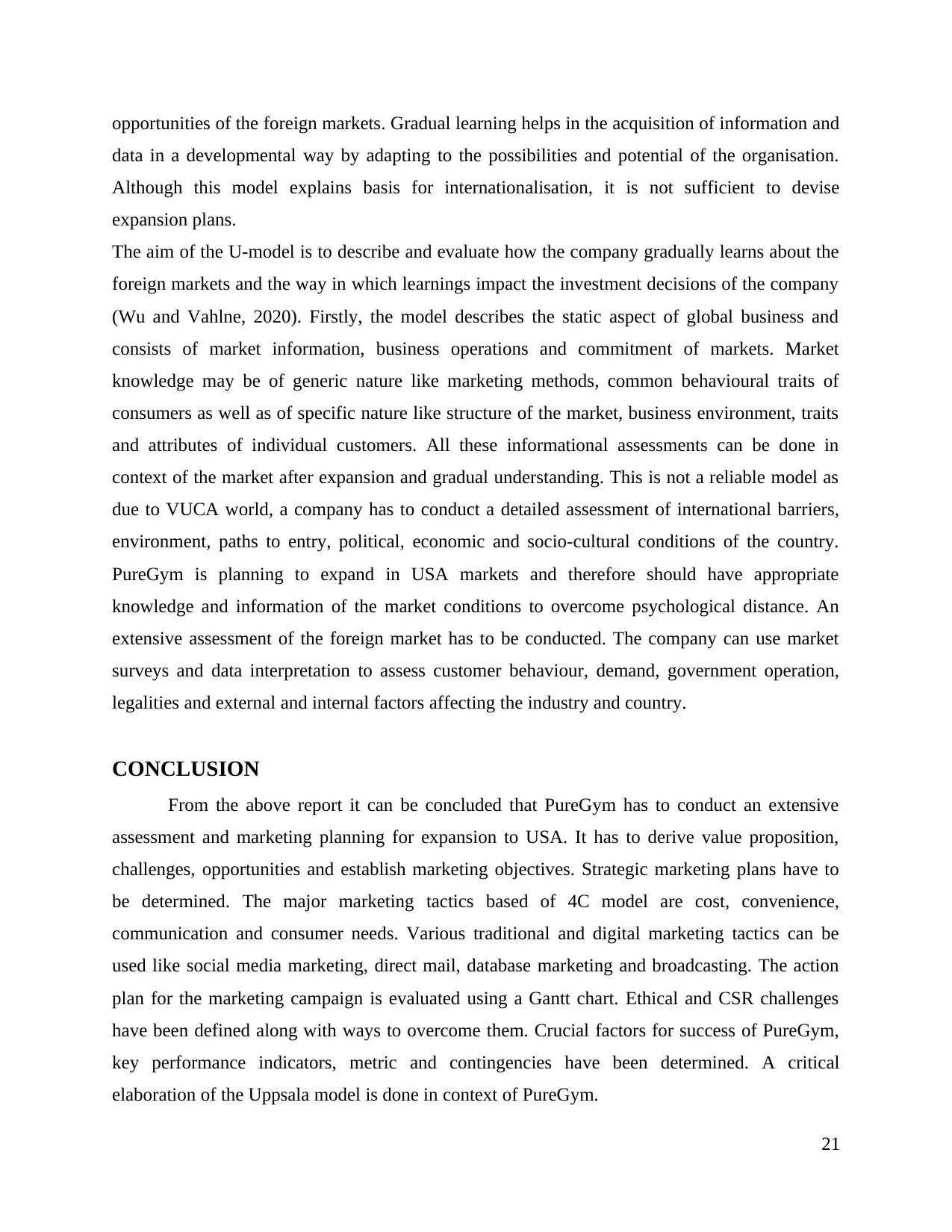
opportunities of the foreign markets. Gradual learning helps in the acquisition of information and
data in a developmental way by adapting to the possibilities and potential of the organisation.
Although this model explains basis for internationalisation, it is not sufficient to devise
expansion plans.
The aim of the U-model is to describe and evaluate how the company gradually learns about the
foreign markets and the way in which learnings impact the investment decisions of the company
(Wu and Vahlne, 2020). Firstly, the model describes the static aspect of global business and
consists of market information, business operations and commitment of markets. Market
knowledge may be of generic nature like marketing methods, common behavioural traits of
consumers as well as of specific nature like structure of the market, business environment, traits
and attributes of individual customers. All these informational assessments can be done in
context of the market after expansion and gradual understanding. This is not a reliable model as
due to VUCA world, a company has to conduct a detailed assessment of international barriers,
environment, paths to entry, political, economic and socio-cultural conditions of the country.
PureGym is planning to expand in USA markets and therefore should have appropriate
knowledge and information of the market conditions to overcome psychological distance. An
extensive assessment of the foreign market has to be conducted. The company can use market
surveys and data interpretation to assess customer behaviour, demand, government operation,
legalities and external and internal factors affecting the industry and country.
CONCLUSION
From the above report it can be concluded that PureGym has to conduct an extensive
assessment and marketing planning for expansion to USA. It has to derive value proposition,
challenges, opportunities and establish marketing objectives. Strategic marketing plans have to
be determined. The major marketing tactics based of 4C model are cost, convenience,
communication and consumer needs. Various traditional and digital marketing tactics can be
used like social media marketing, direct mail, database marketing and broadcasting. The action
plan for the marketing campaign is evaluated using a Gantt chart. Ethical and CSR challenges
have been defined along with ways to overcome them. Crucial factors for success of PureGym,
key performance indicators, metric and contingencies have been determined. A critical
elaboration of the Uppsala model is done in context of PureGym.
21
data in a developmental way by adapting to the possibilities and potential of the organisation.
Although this model explains basis for internationalisation, it is not sufficient to devise
expansion plans.
The aim of the U-model is to describe and evaluate how the company gradually learns about the
foreign markets and the way in which learnings impact the investment decisions of the company
(Wu and Vahlne, 2020). Firstly, the model describes the static aspect of global business and
consists of market information, business operations and commitment of markets. Market
knowledge may be of generic nature like marketing methods, common behavioural traits of
consumers as well as of specific nature like structure of the market, business environment, traits
and attributes of individual customers. All these informational assessments can be done in
context of the market after expansion and gradual understanding. This is not a reliable model as
due to VUCA world, a company has to conduct a detailed assessment of international barriers,
environment, paths to entry, political, economic and socio-cultural conditions of the country.
PureGym is planning to expand in USA markets and therefore should have appropriate
knowledge and information of the market conditions to overcome psychological distance. An
extensive assessment of the foreign market has to be conducted. The company can use market
surveys and data interpretation to assess customer behaviour, demand, government operation,
legalities and external and internal factors affecting the industry and country.
CONCLUSION
From the above report it can be concluded that PureGym has to conduct an extensive
assessment and marketing planning for expansion to USA. It has to derive value proposition,
challenges, opportunities and establish marketing objectives. Strategic marketing plans have to
be determined. The major marketing tactics based of 4C model are cost, convenience,
communication and consumer needs. Various traditional and digital marketing tactics can be
used like social media marketing, direct mail, database marketing and broadcasting. The action
plan for the marketing campaign is evaluated using a Gantt chart. Ethical and CSR challenges
have been defined along with ways to overcome them. Crucial factors for success of PureGym,
key performance indicators, metric and contingencies have been determined. A critical
elaboration of the Uppsala model is done in context of PureGym.
21
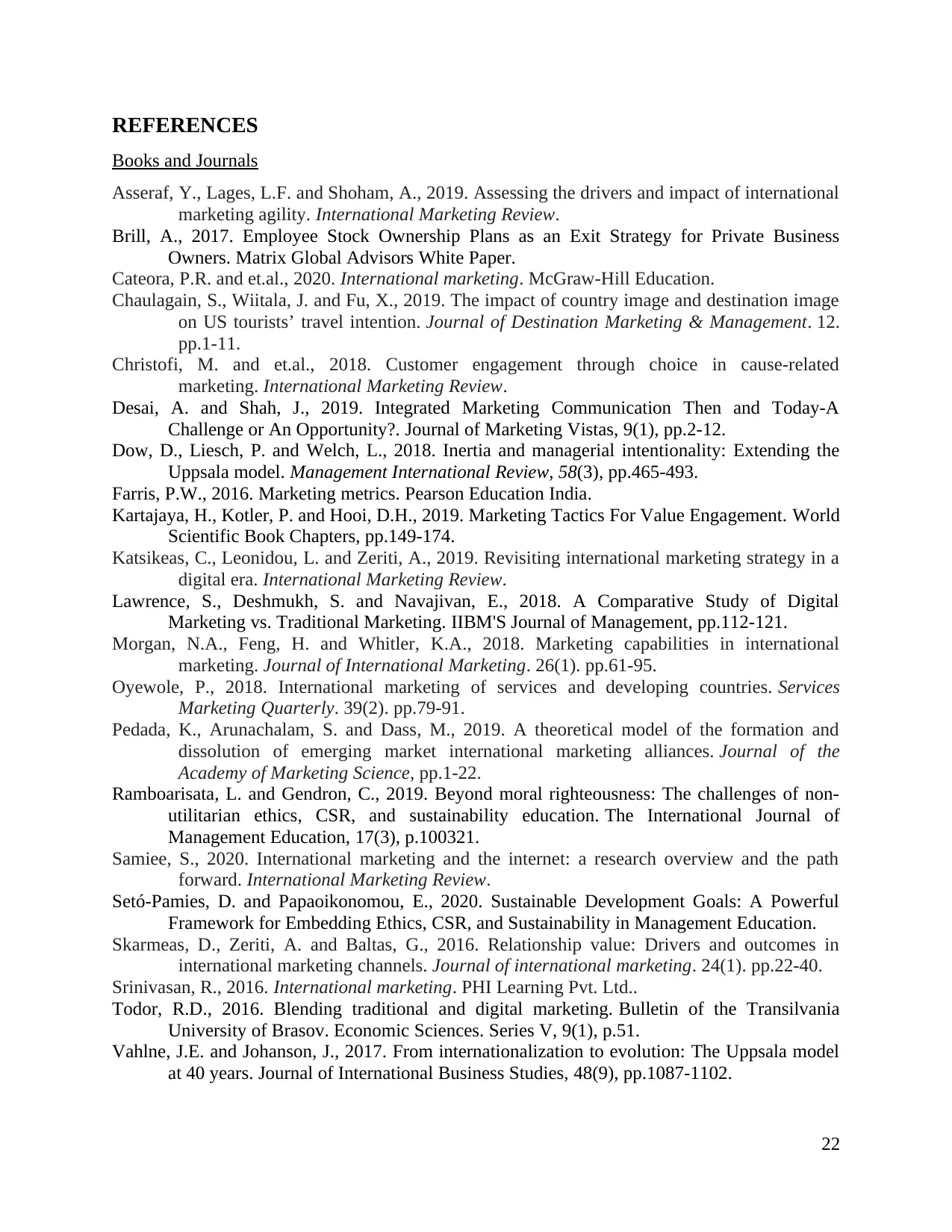
REFERENCES
Books and Journals
Asseraf, Y., Lages, L.F. and Shoham, A., 2019. Assessing the drivers and impact of international
marketing agility. International Marketing Review.
Brill, A., 2017. Employee Stock Ownership Plans as an Exit Strategy for Private Business
Owners. Matrix Global Advisors White Paper.
Cateora, P.R. and et.al., 2020. International marketing. McGraw-Hill Education.
Chaulagain, S., Wiitala, J. and Fu, X., 2019. The impact of country image and destination image
on US tourists’ travel intention. Journal of Destination Marketing & Management. 12.
pp.1-11.
Christofi, M. and et.al., 2018. Customer engagement through choice in cause-related
marketing. International Marketing Review.
Desai, A. and Shah, J., 2019. Integrated Marketing Communication Then and Today-A
Challenge or An Opportunity?. Journal of Marketing Vistas, 9(1), pp.2-12.
Dow, D., Liesch, P. and Welch, L., 2018. Inertia and managerial intentionality: Extending the
Uppsala model. Management International Review, 58(3), pp.465-493.
Farris, P.W., 2016. Marketing metrics. Pearson Education India.
Kartajaya, H., Kotler, P. and Hooi, D.H., 2019. Marketing Tactics For Value Engagement. World
Scientific Book Chapters, pp.149-174.
Katsikeas, C., Leonidou, L. and Zeriti, A., 2019. Revisiting international marketing strategy in a
digital era. International Marketing Review.
Lawrence, S., Deshmukh, S. and Navajivan, E., 2018. A Comparative Study of Digital
Marketing vs. Traditional Marketing. IIBM'S Journal of Management, pp.112-121.
Morgan, N.A., Feng, H. and Whitler, K.A., 2018. Marketing capabilities in international
marketing. Journal of International Marketing. 26(1). pp.61-95.
Oyewole, P., 2018. International marketing of services and developing countries. Services
Marketing Quarterly. 39(2). pp.79-91.
Pedada, K., Arunachalam, S. and Dass, M., 2019. A theoretical model of the formation and
dissolution of emerging market international marketing alliances. Journal of the
Academy of Marketing Science, pp.1-22.
Ramboarisata, L. and Gendron, C., 2019. Beyond moral righteousness: The challenges of non-
utilitarian ethics, CSR, and sustainability education. The International Journal of
Management Education, 17(3), p.100321.
Samiee, S., 2020. International marketing and the internet: a research overview and the path
forward. International Marketing Review.
Setó-Pamies, D. and Papaoikonomou, E., 2020. Sustainable Development Goals: A Powerful
Framework for Embedding Ethics, CSR, and Sustainability in Management Education.
Skarmeas, D., Zeriti, A. and Baltas, G., 2016. Relationship value: Drivers and outcomes in
international marketing channels. Journal of international marketing. 24(1). pp.22-40.
Srinivasan, R., 2016. International marketing. PHI Learning Pvt. Ltd..
Todor, R.D., 2016. Blending traditional and digital marketing. Bulletin of the Transilvania
University of Brasov. Economic Sciences. Series V, 9(1), p.51.
Vahlne, J.E. and Johanson, J., 2017. From internationalization to evolution: The Uppsala model
at 40 years. Journal of International Business Studies, 48(9), pp.1087-1102.
22
Books and Journals
Asseraf, Y., Lages, L.F. and Shoham, A., 2019. Assessing the drivers and impact of international
marketing agility. International Marketing Review.
Brill, A., 2017. Employee Stock Ownership Plans as an Exit Strategy for Private Business
Owners. Matrix Global Advisors White Paper.
Cateora, P.R. and et.al., 2020. International marketing. McGraw-Hill Education.
Chaulagain, S., Wiitala, J. and Fu, X., 2019. The impact of country image and destination image
on US tourists’ travel intention. Journal of Destination Marketing & Management. 12.
pp.1-11.
Christofi, M. and et.al., 2018. Customer engagement through choice in cause-related
marketing. International Marketing Review.
Desai, A. and Shah, J., 2019. Integrated Marketing Communication Then and Today-A
Challenge or An Opportunity?. Journal of Marketing Vistas, 9(1), pp.2-12.
Dow, D., Liesch, P. and Welch, L., 2018. Inertia and managerial intentionality: Extending the
Uppsala model. Management International Review, 58(3), pp.465-493.
Farris, P.W., 2016. Marketing metrics. Pearson Education India.
Kartajaya, H., Kotler, P. and Hooi, D.H., 2019. Marketing Tactics For Value Engagement. World
Scientific Book Chapters, pp.149-174.
Katsikeas, C., Leonidou, L. and Zeriti, A., 2019. Revisiting international marketing strategy in a
digital era. International Marketing Review.
Lawrence, S., Deshmukh, S. and Navajivan, E., 2018. A Comparative Study of Digital
Marketing vs. Traditional Marketing. IIBM'S Journal of Management, pp.112-121.
Morgan, N.A., Feng, H. and Whitler, K.A., 2018. Marketing capabilities in international
marketing. Journal of International Marketing. 26(1). pp.61-95.
Oyewole, P., 2018. International marketing of services and developing countries. Services
Marketing Quarterly. 39(2). pp.79-91.
Pedada, K., Arunachalam, S. and Dass, M., 2019. A theoretical model of the formation and
dissolution of emerging market international marketing alliances. Journal of the
Academy of Marketing Science, pp.1-22.
Ramboarisata, L. and Gendron, C., 2019. Beyond moral righteousness: The challenges of non-
utilitarian ethics, CSR, and sustainability education. The International Journal of
Management Education, 17(3), p.100321.
Samiee, S., 2020. International marketing and the internet: a research overview and the path
forward. International Marketing Review.
Setó-Pamies, D. and Papaoikonomou, E., 2020. Sustainable Development Goals: A Powerful
Framework for Embedding Ethics, CSR, and Sustainability in Management Education.
Skarmeas, D., Zeriti, A. and Baltas, G., 2016. Relationship value: Drivers and outcomes in
international marketing channels. Journal of international marketing. 24(1). pp.22-40.
Srinivasan, R., 2016. International marketing. PHI Learning Pvt. Ltd..
Todor, R.D., 2016. Blending traditional and digital marketing. Bulletin of the Transilvania
University of Brasov. Economic Sciences. Series V, 9(1), p.51.
Vahlne, J.E. and Johanson, J., 2017. From internationalization to evolution: The Uppsala model
at 40 years. Journal of International Business Studies, 48(9), pp.1087-1102.
22
Secure Best Marks with AI Grader
Need help grading? Try our AI Grader for instant feedback on your assignments.
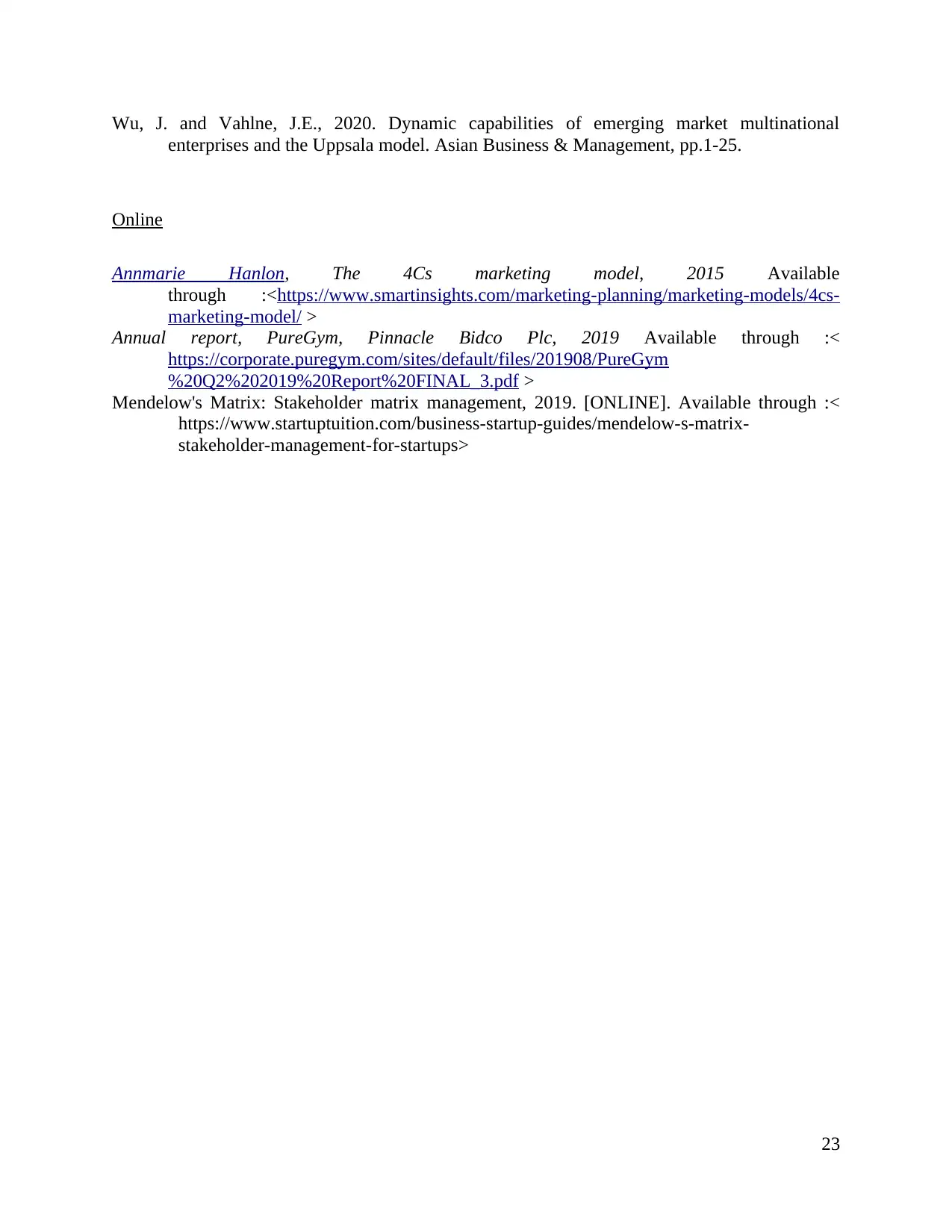
Wu, J. and Vahlne, J.E., 2020. Dynamic capabilities of emerging market multinational
enterprises and the Uppsala model. Asian Business & Management, pp.1-25.
Online
Annmarie Hanlon, The 4Cs marketing model, 2015 Available
through :<https://www.smartinsights.com/marketing-planning/marketing-models/4cs-
marketing-model/ >
Annual report, PureGym, Pinnacle Bidco Plc, 2019 Available through :<
https://corporate.puregym.com/sites/default/files/201908/PureGym
%20Q2%202019%20Report%20FINAL_3.pdf >
Mendelow's Matrix: Stakeholder matrix management, 2019. [ONLINE]. Available through :<
https://www.startuptuition.com/business-startup-guides/mendelow-s-matrix-
stakeholder-management-for-startups>
23
enterprises and the Uppsala model. Asian Business & Management, pp.1-25.
Online
Annmarie Hanlon, The 4Cs marketing model, 2015 Available
through :<https://www.smartinsights.com/marketing-planning/marketing-models/4cs-
marketing-model/ >
Annual report, PureGym, Pinnacle Bidco Plc, 2019 Available through :<
https://corporate.puregym.com/sites/default/files/201908/PureGym
%20Q2%202019%20Report%20FINAL_3.pdf >
Mendelow's Matrix: Stakeholder matrix management, 2019. [ONLINE]. Available through :<
https://www.startuptuition.com/business-startup-guides/mendelow-s-matrix-
stakeholder-management-for-startups>
23
1 out of 23
Related Documents
Your All-in-One AI-Powered Toolkit for Academic Success.
+13062052269
info@desklib.com
Available 24*7 on WhatsApp / Email
![[object Object]](/_next/static/media/star-bottom.7253800d.svg)
Unlock your academic potential
© 2024 | Zucol Services PVT LTD | All rights reserved.





